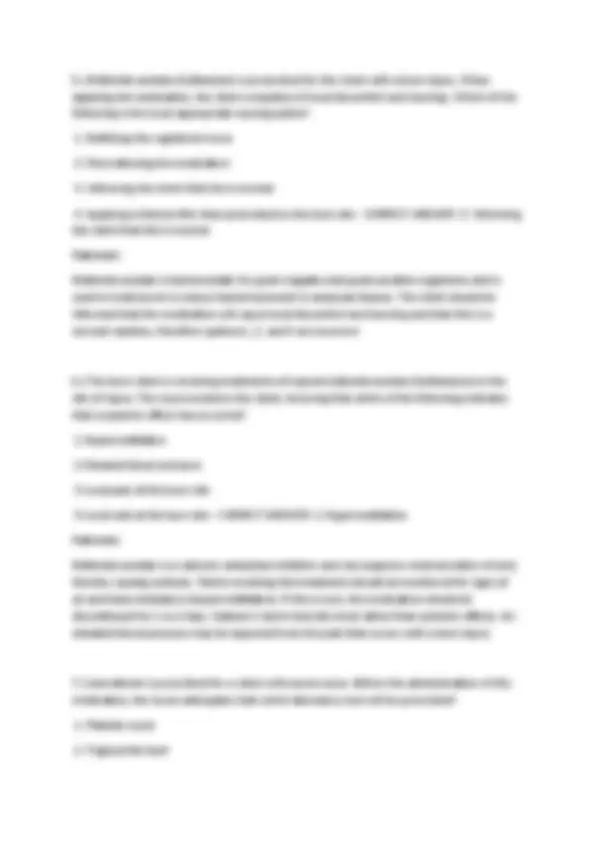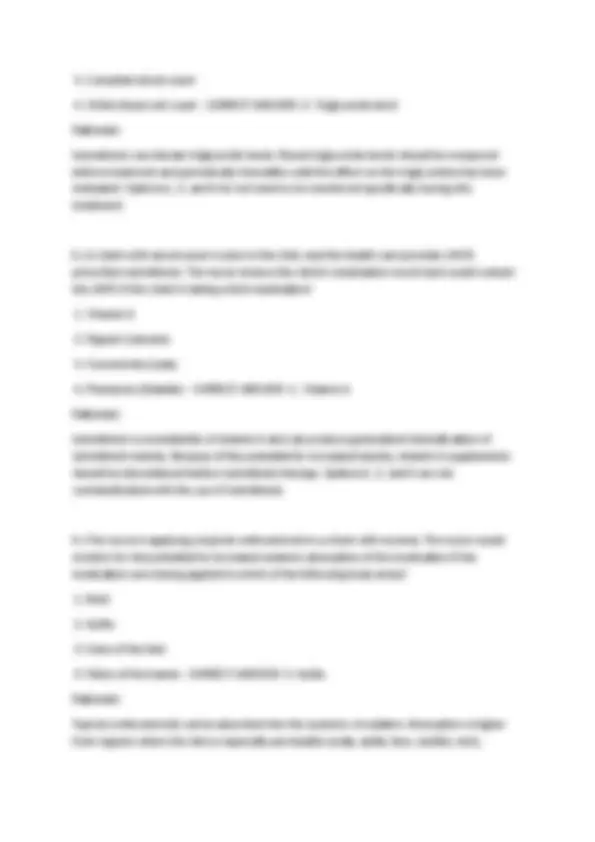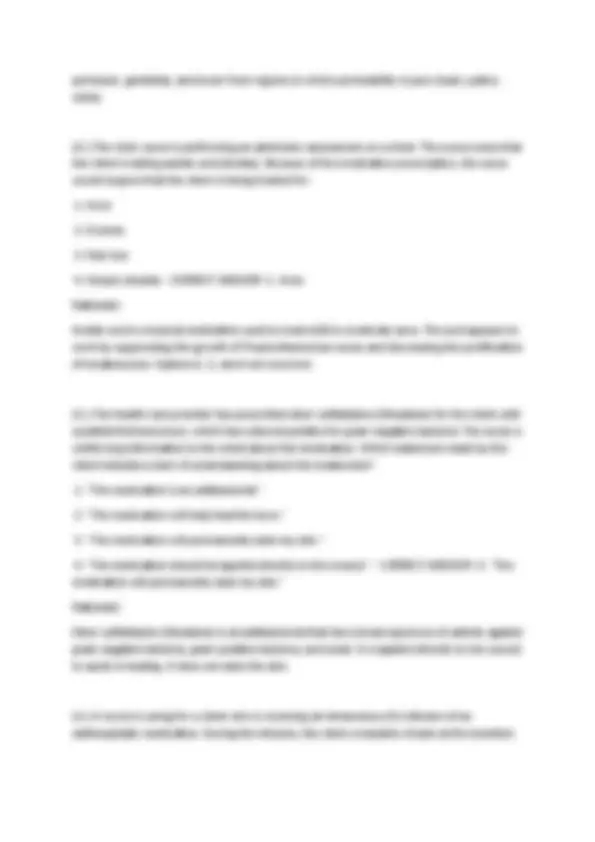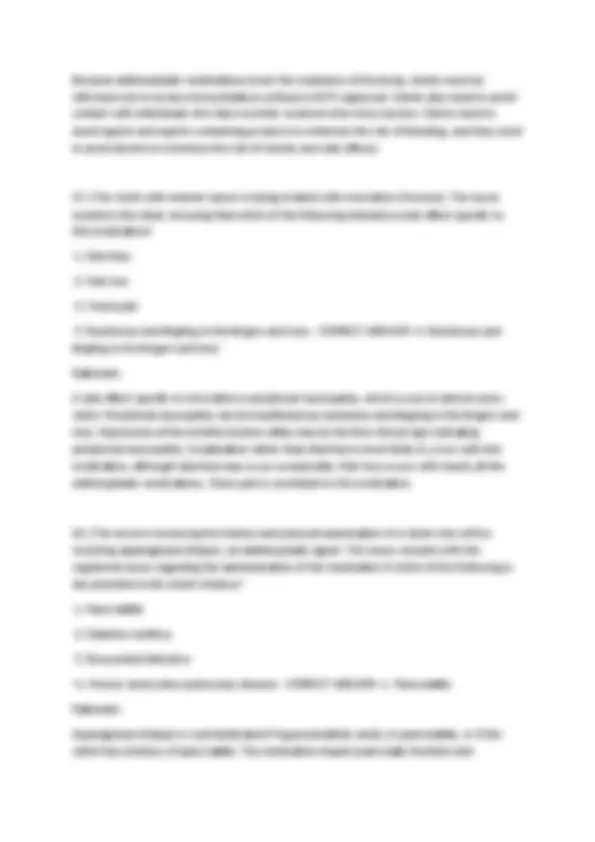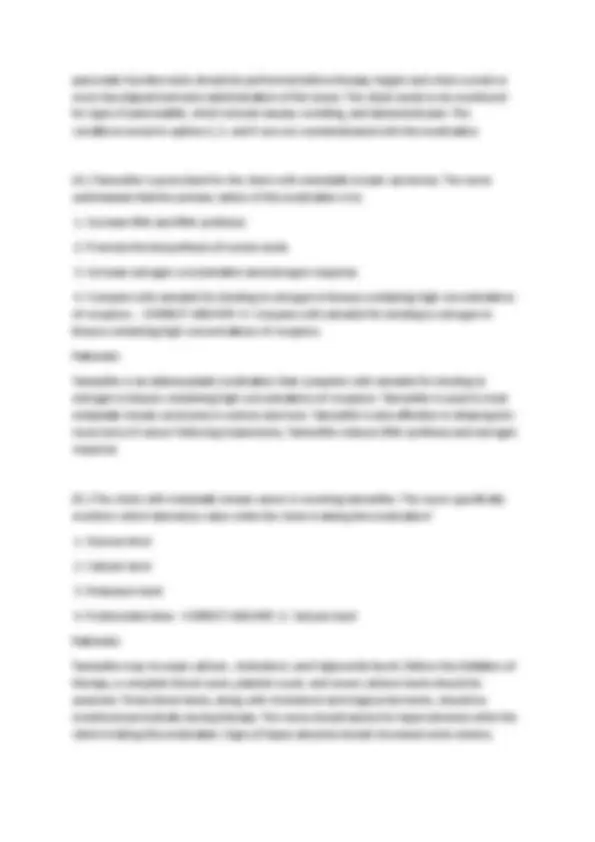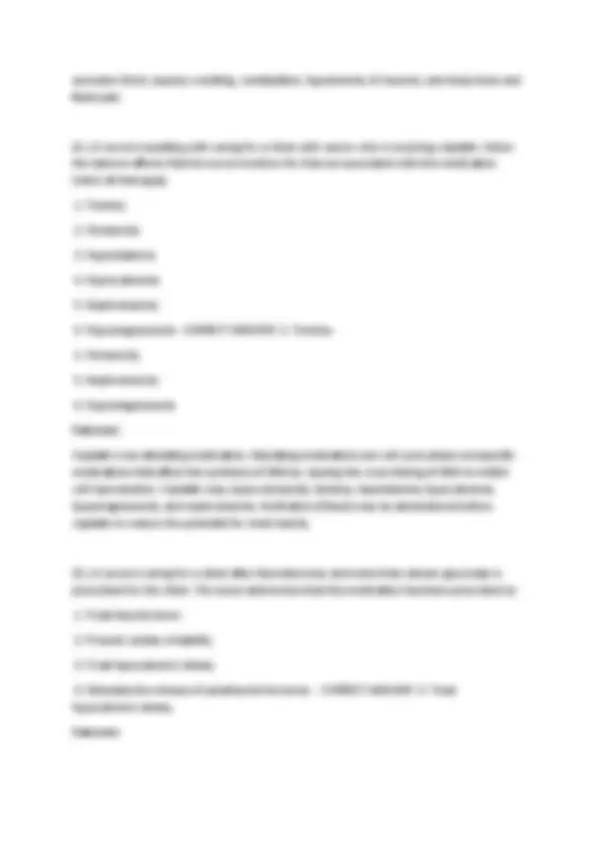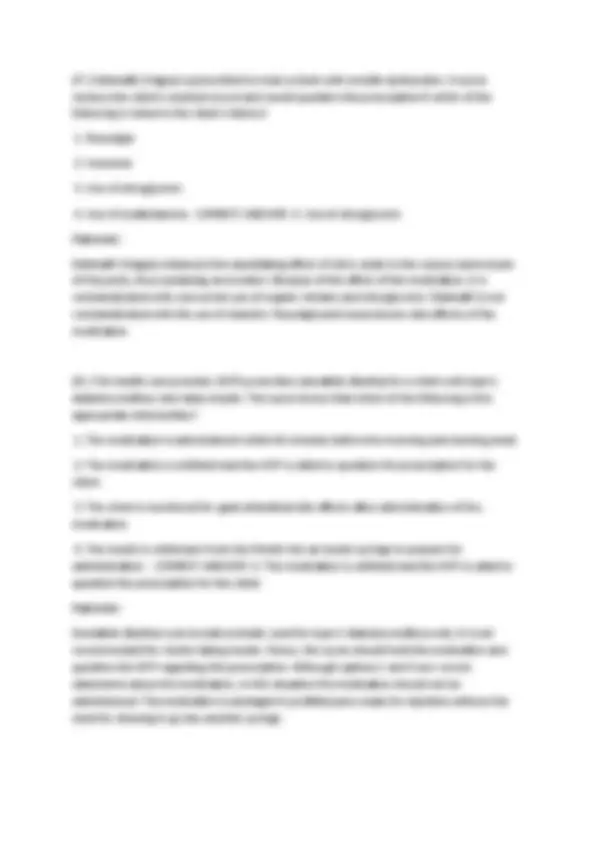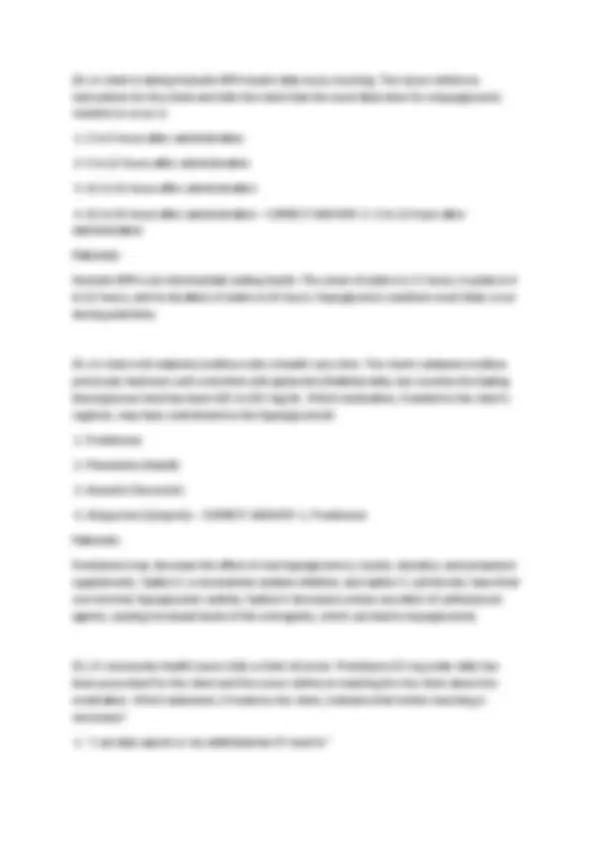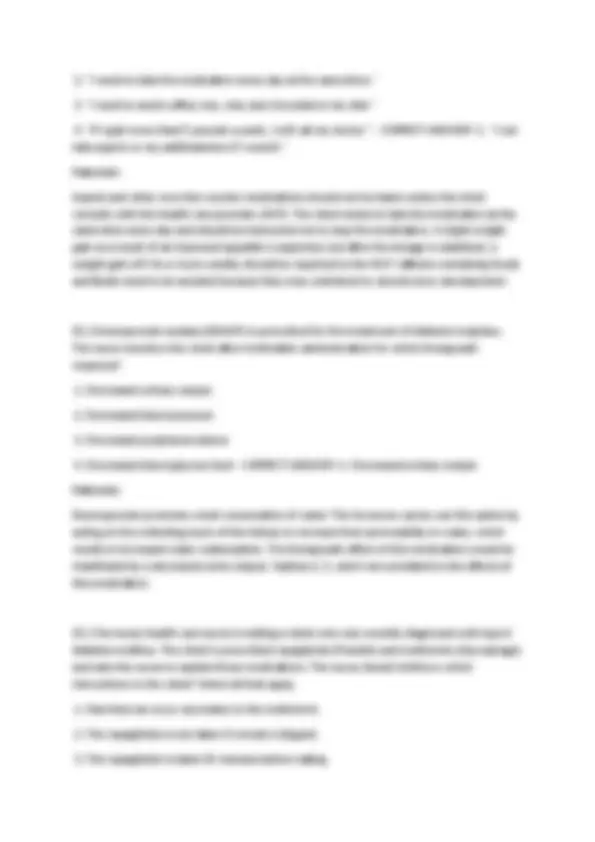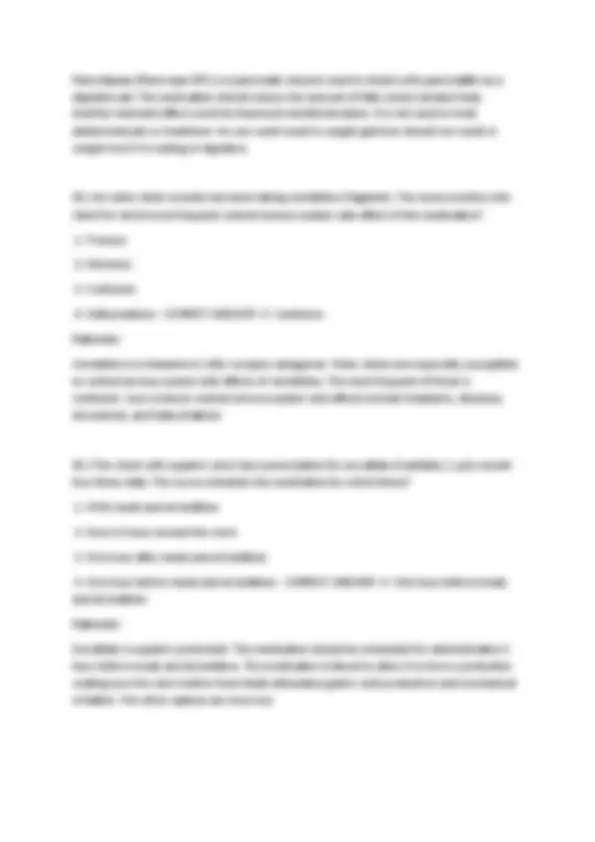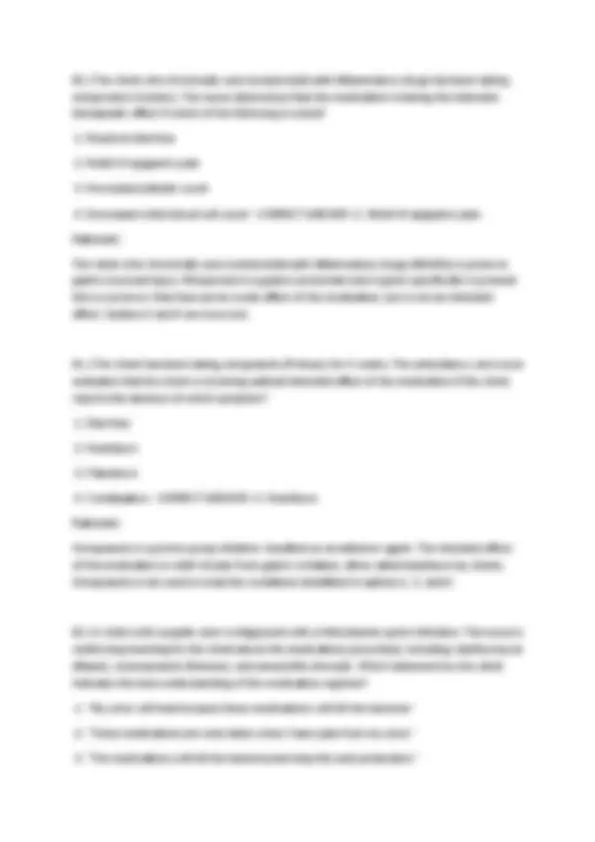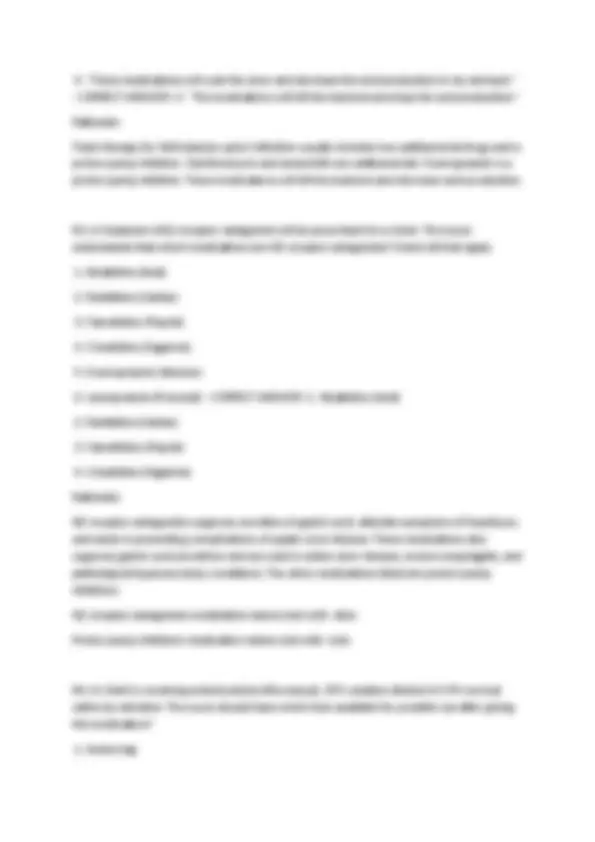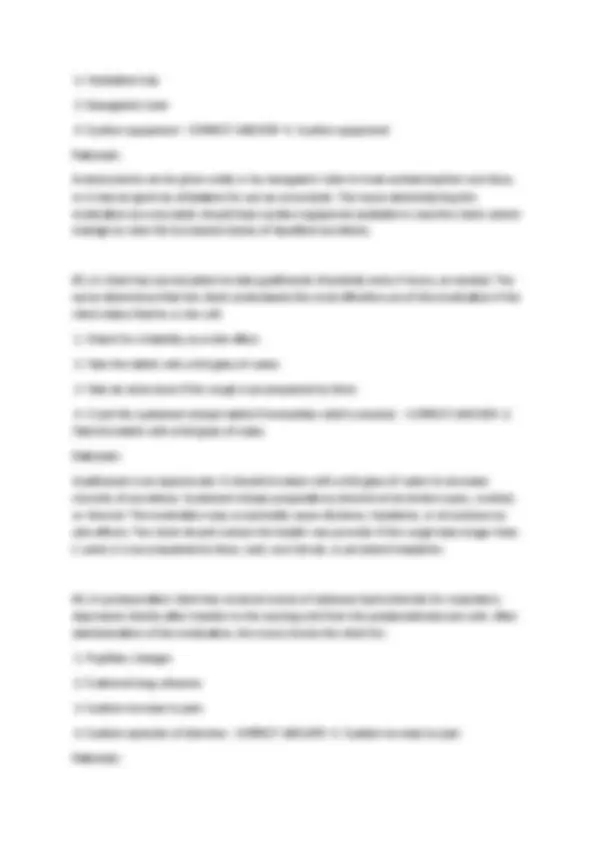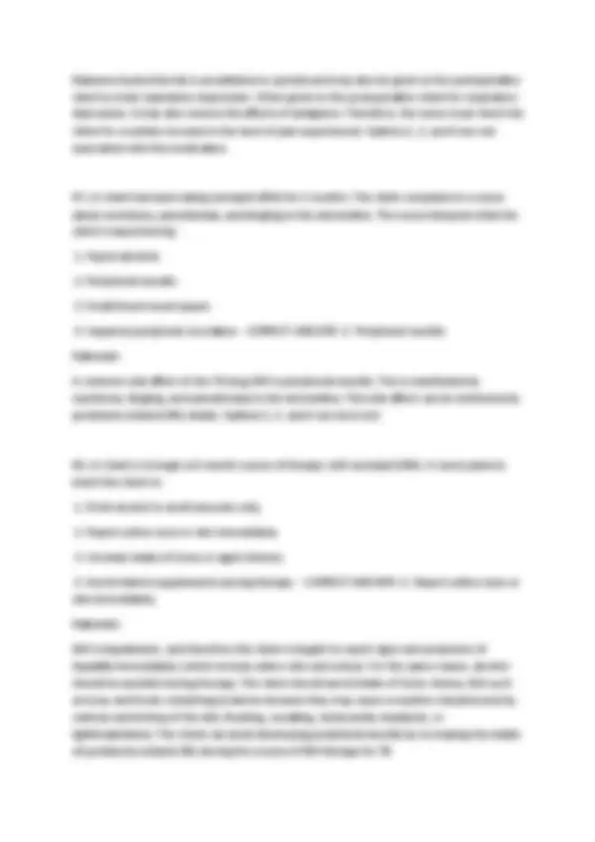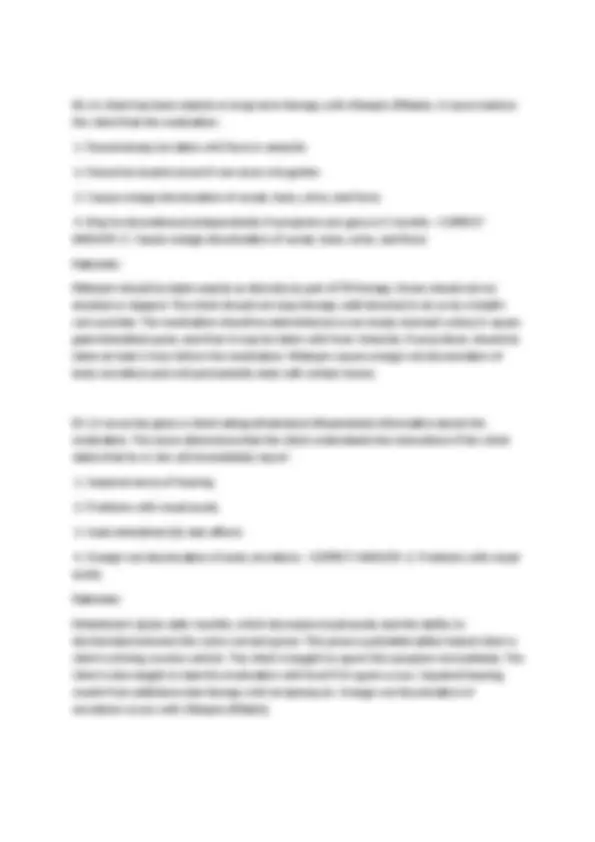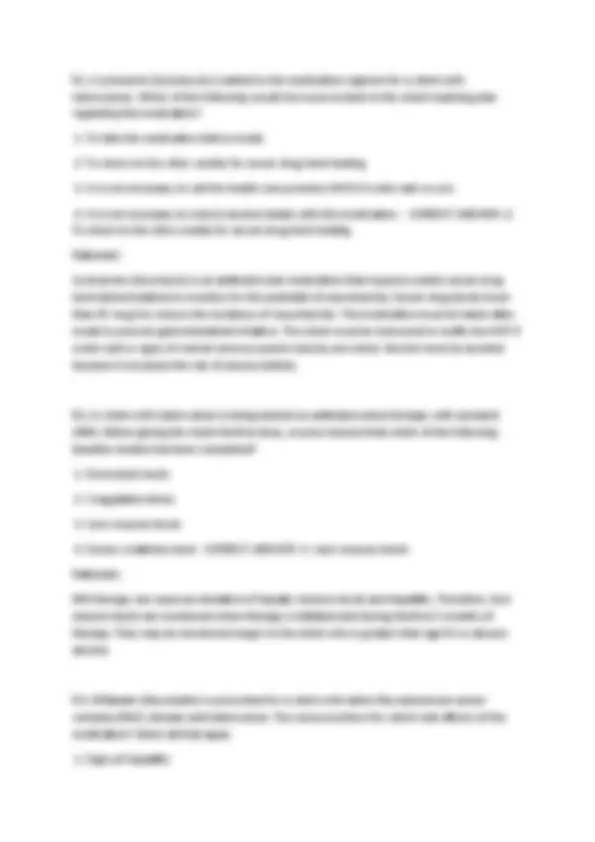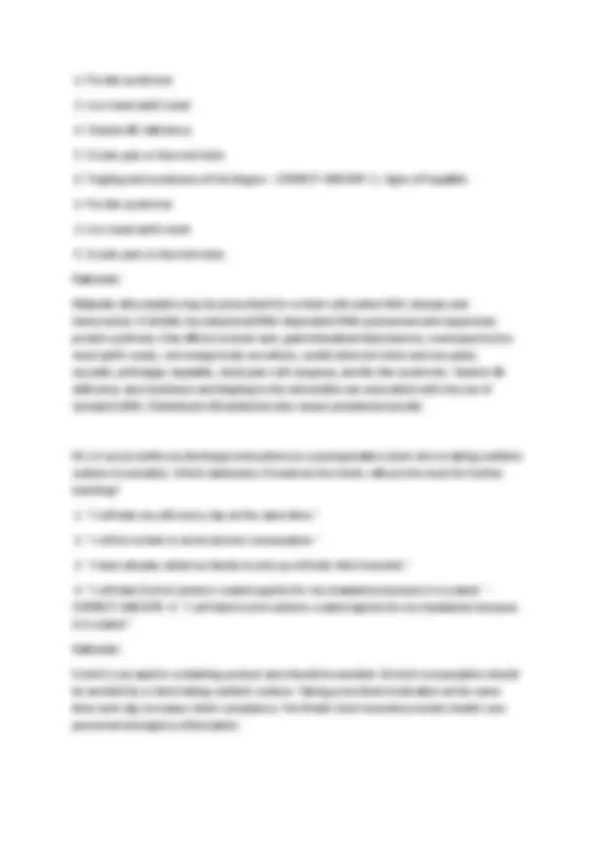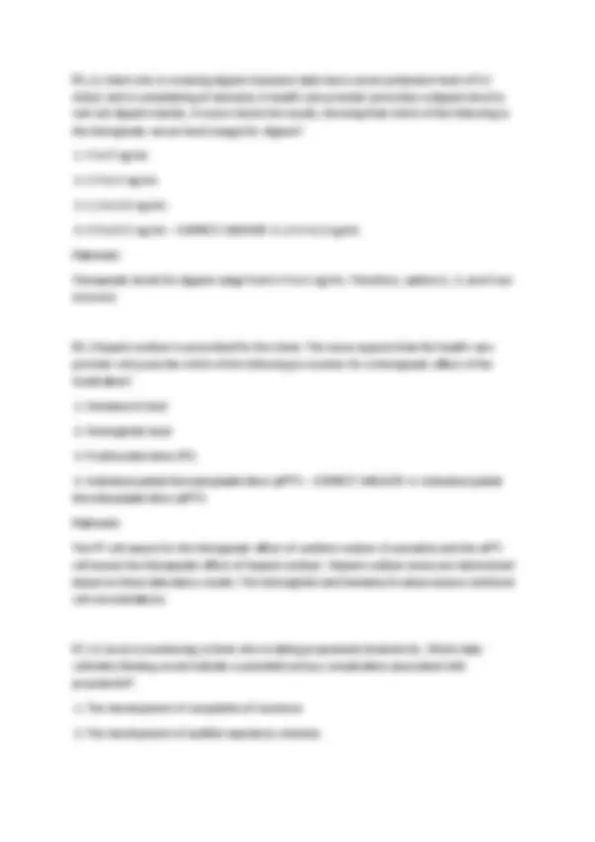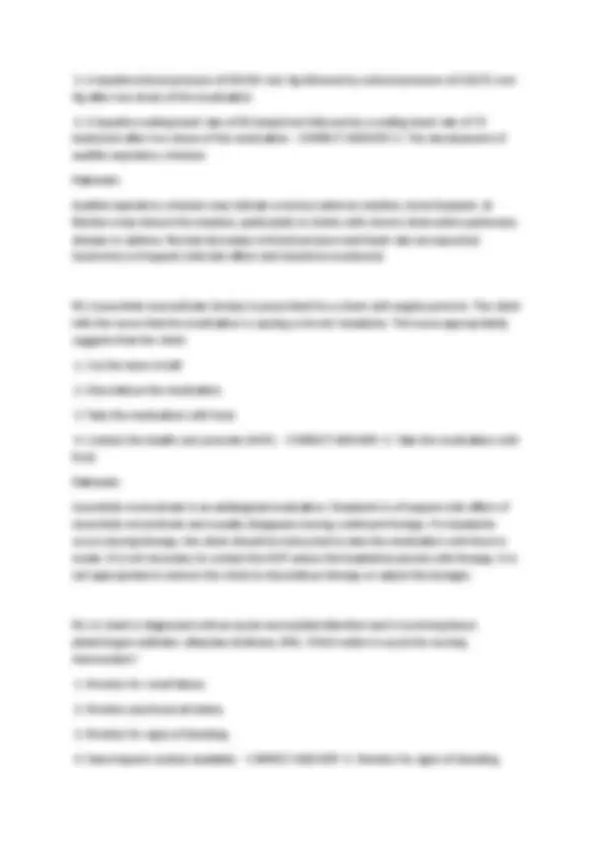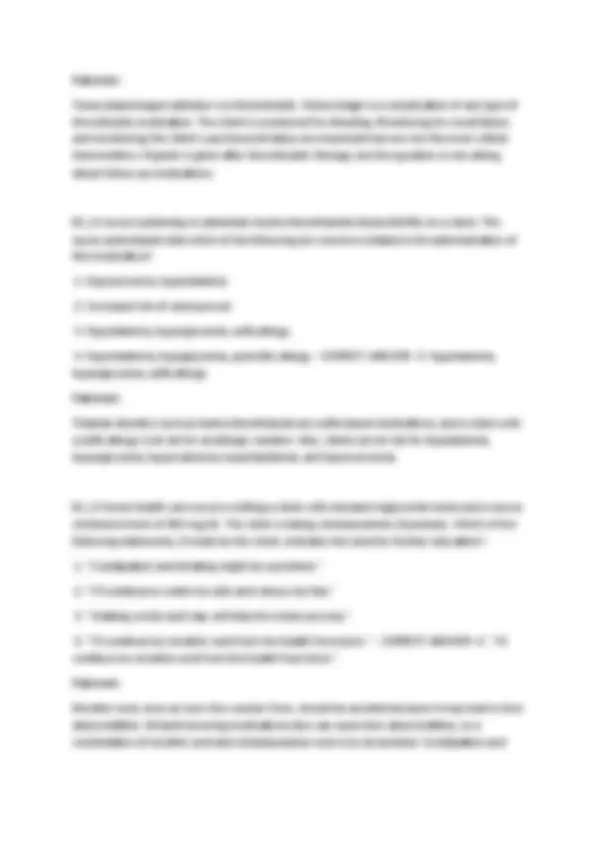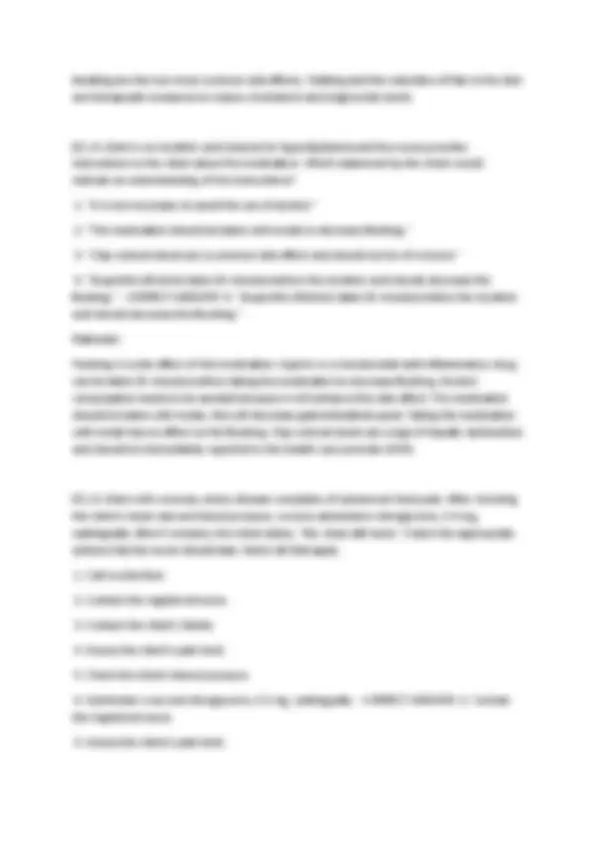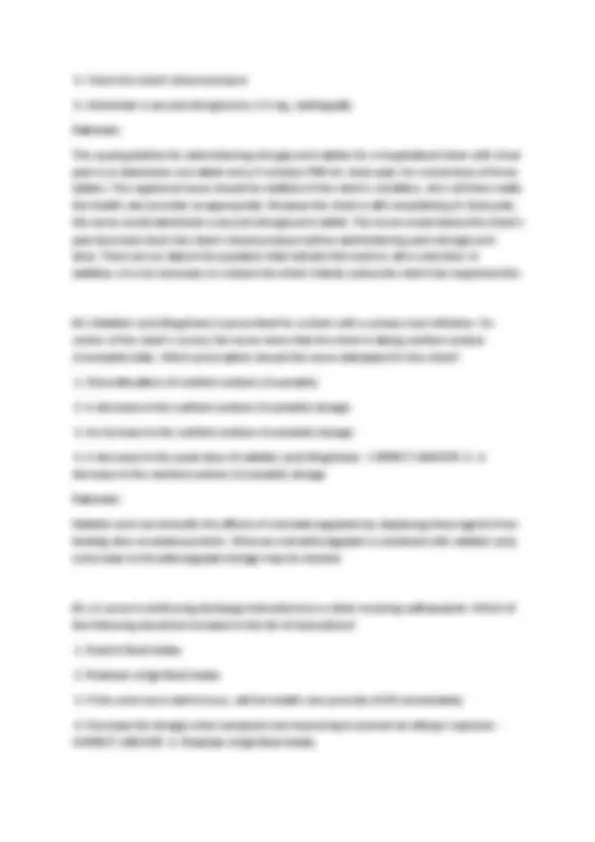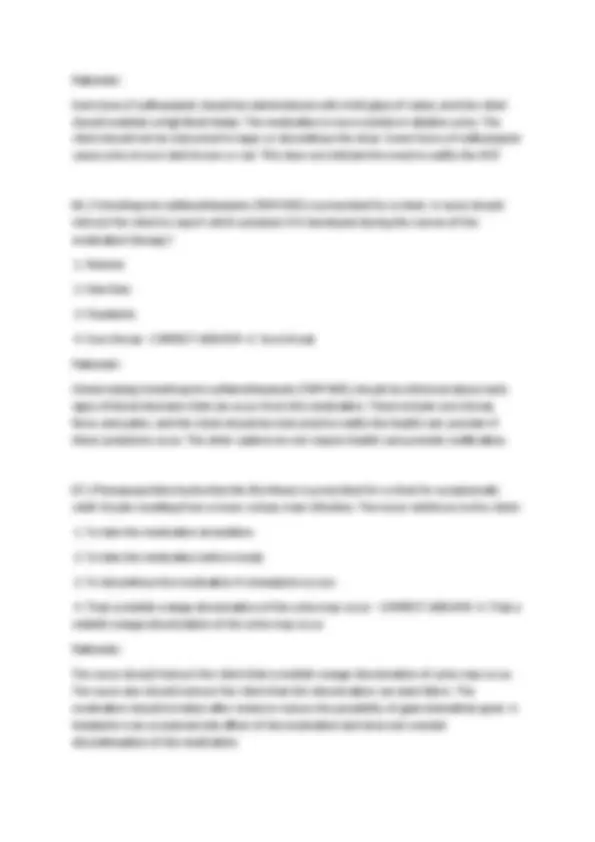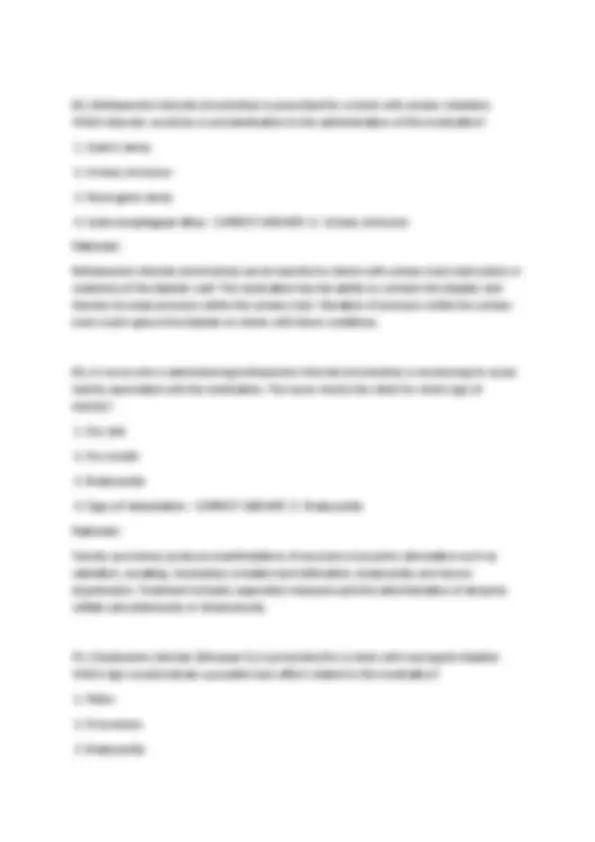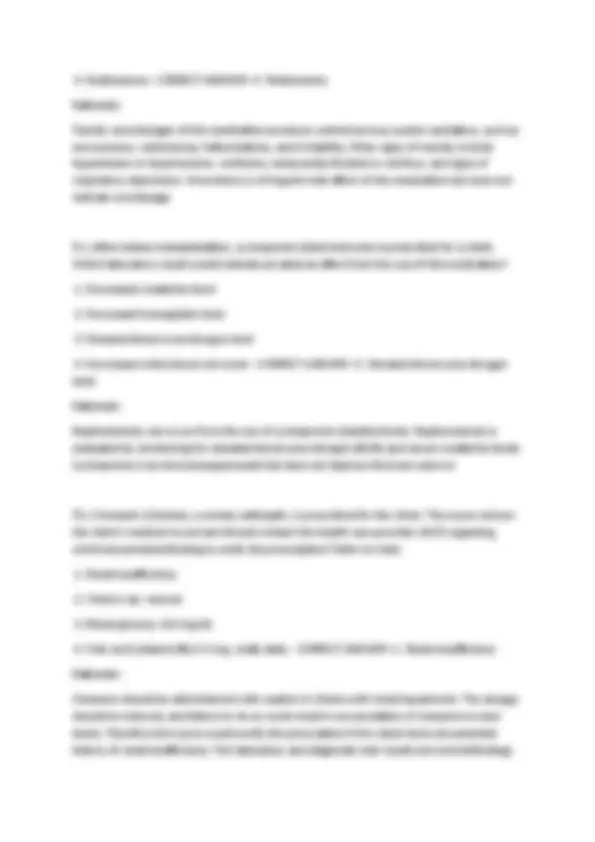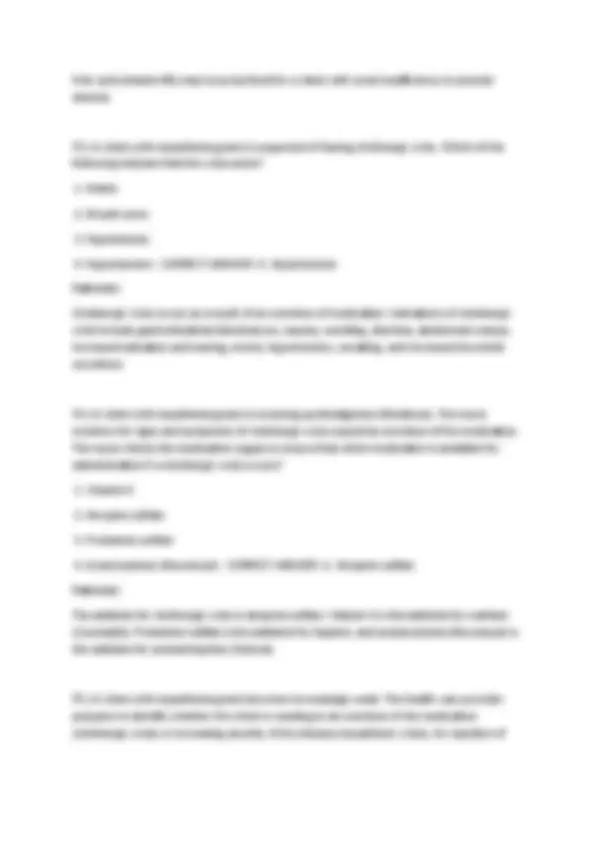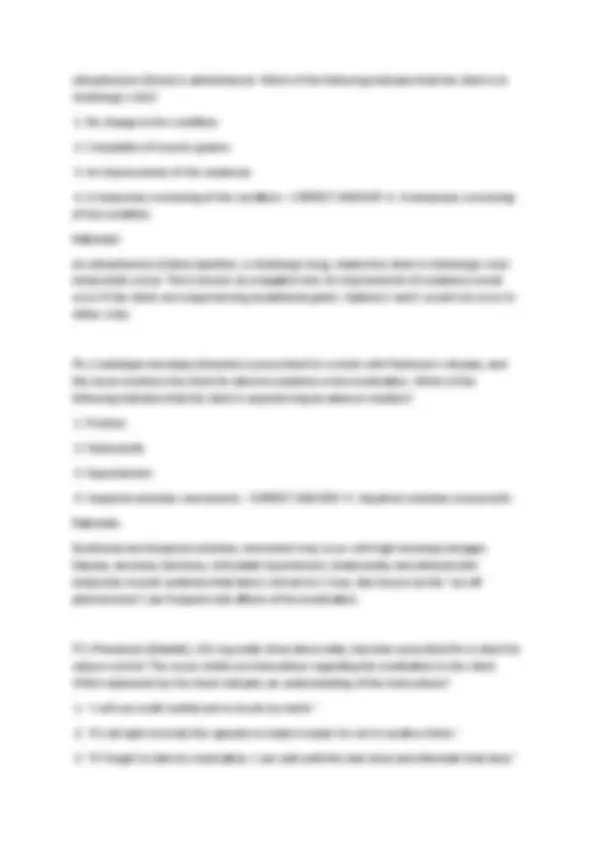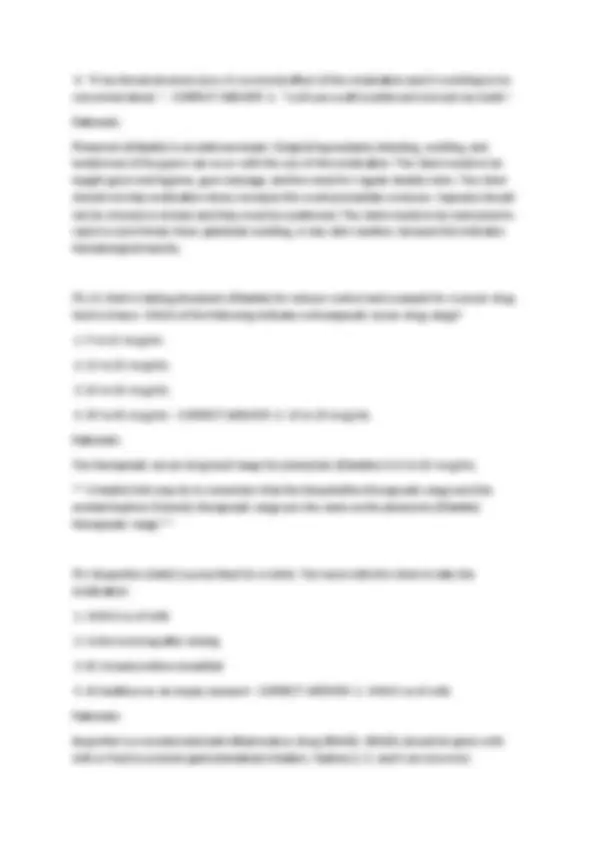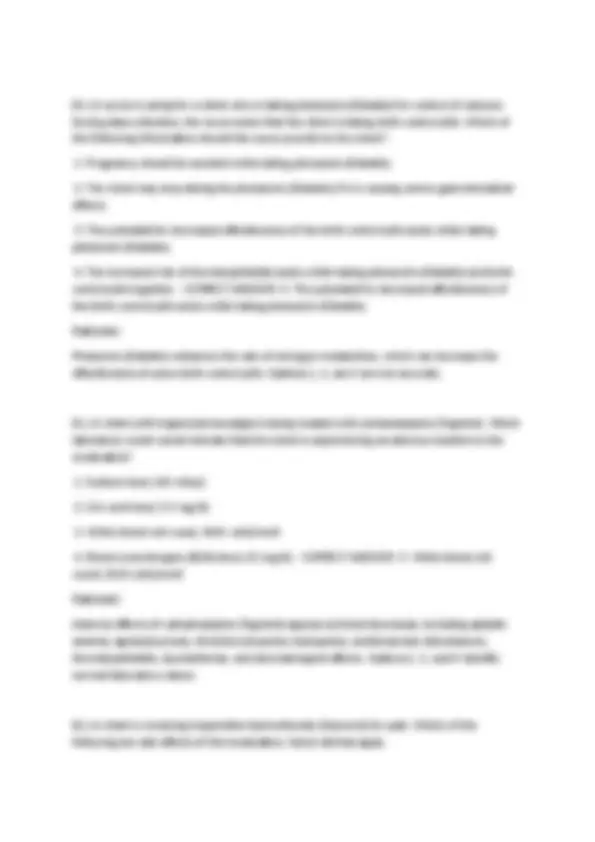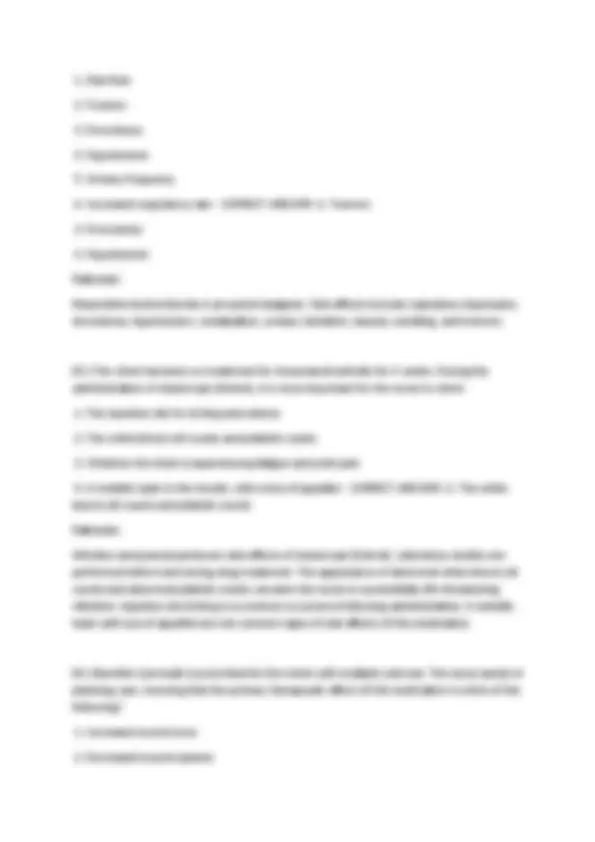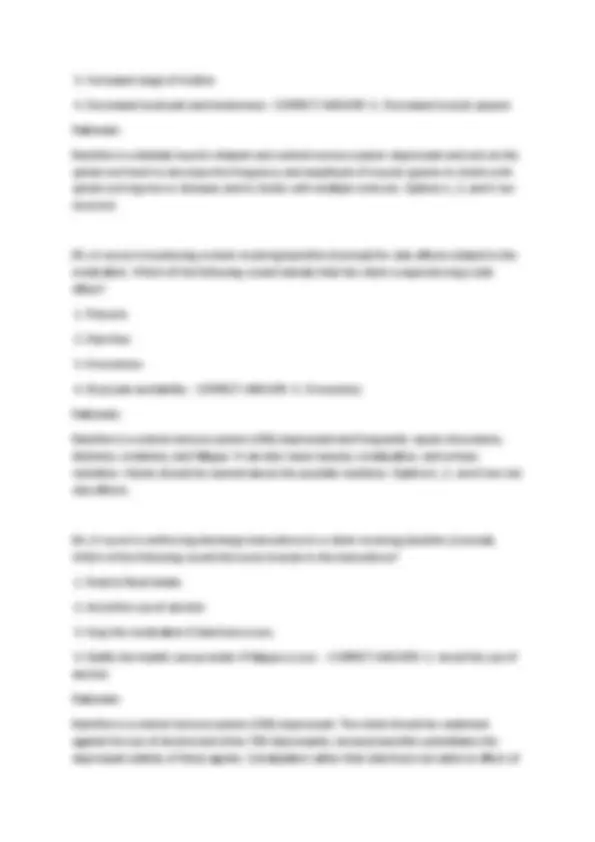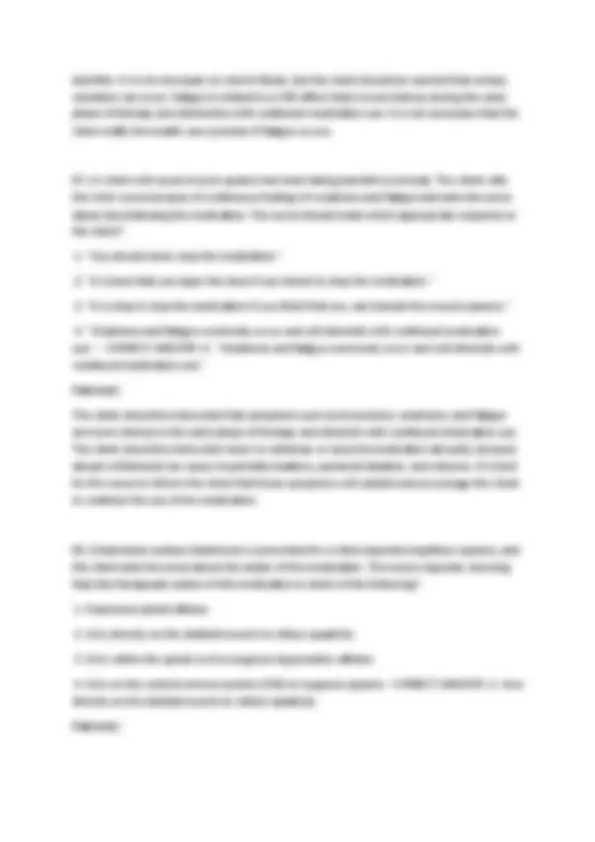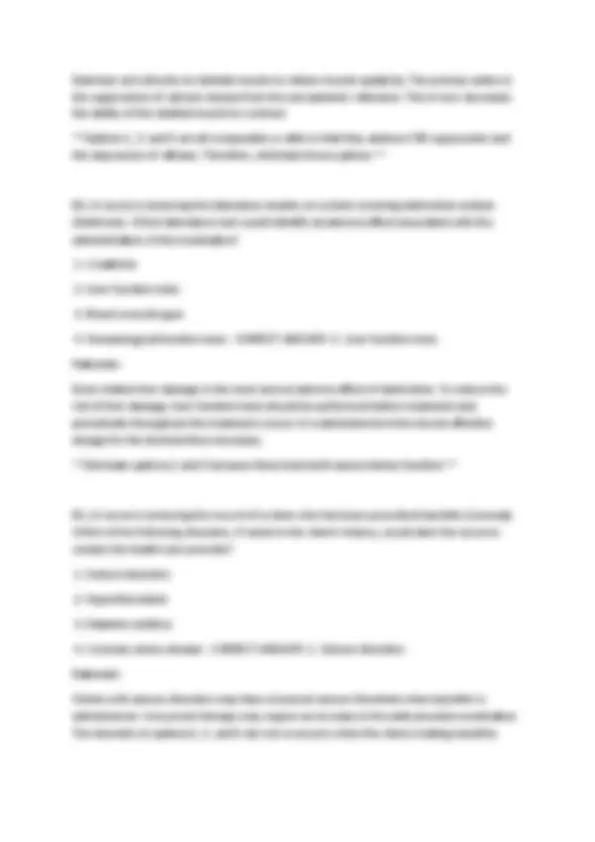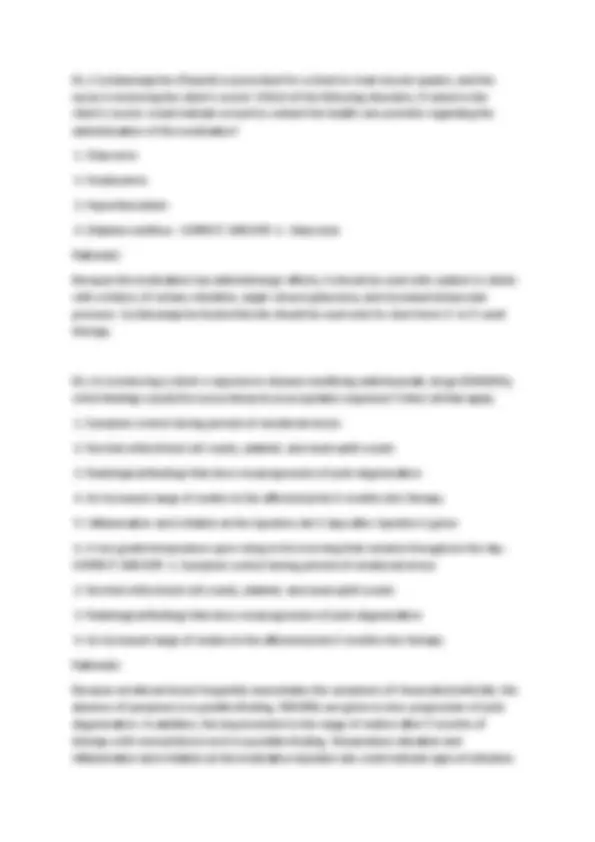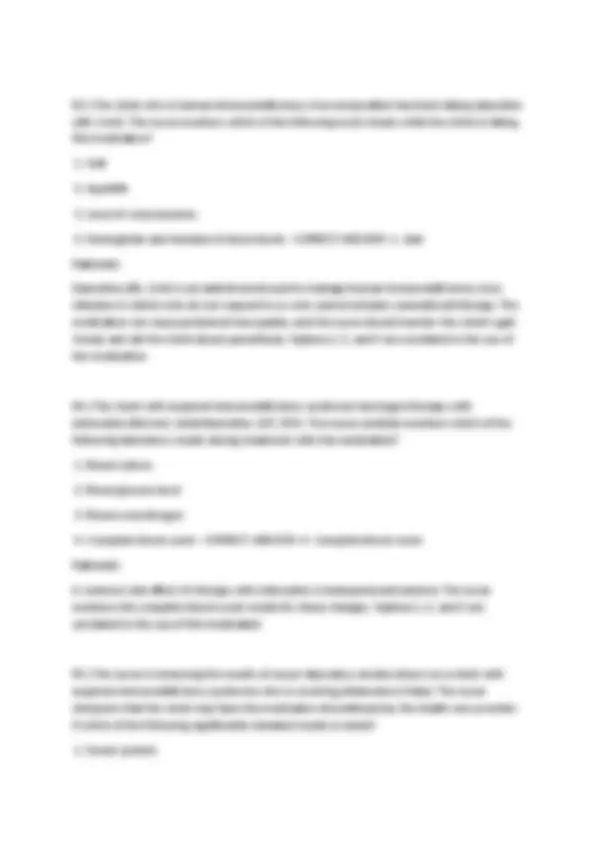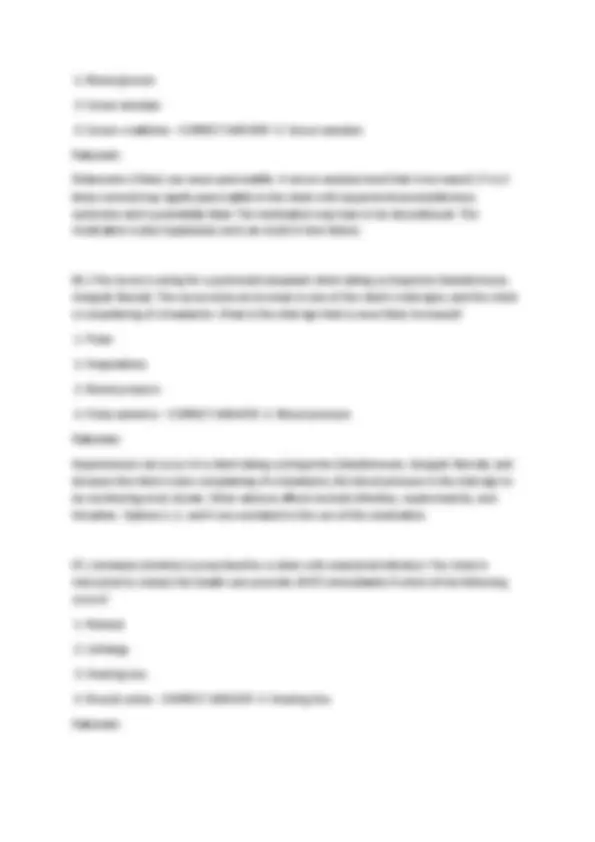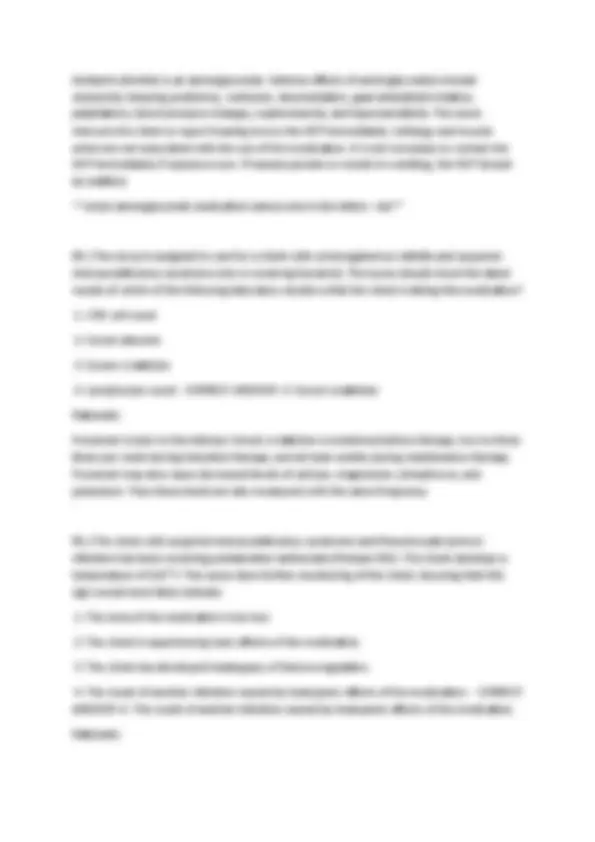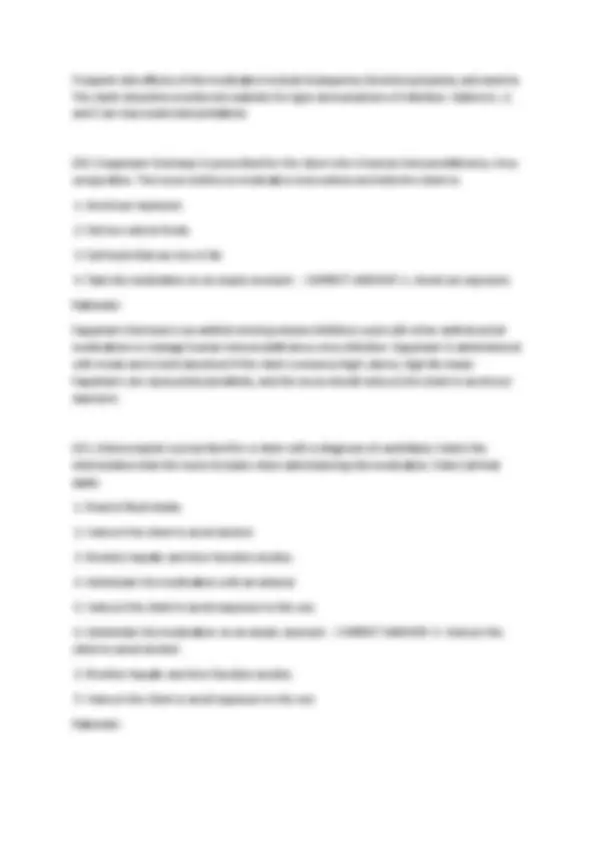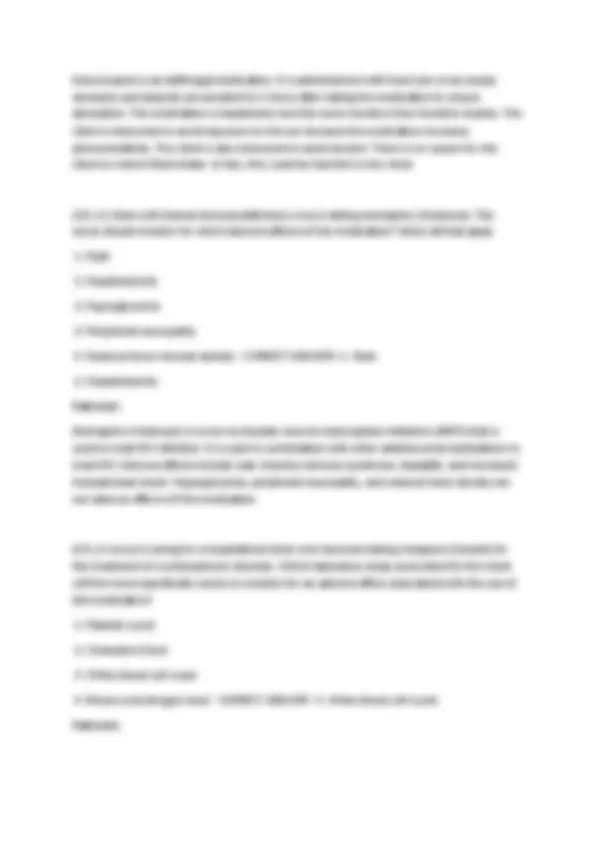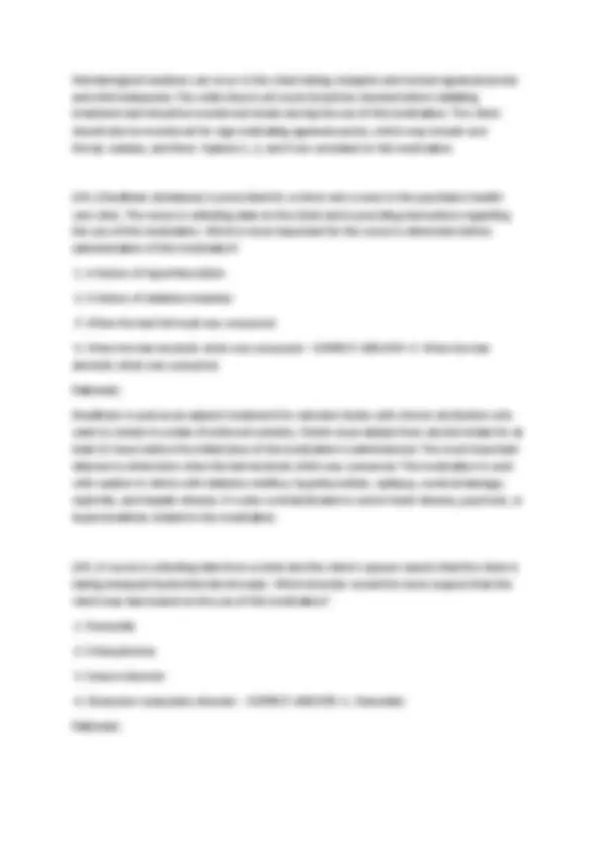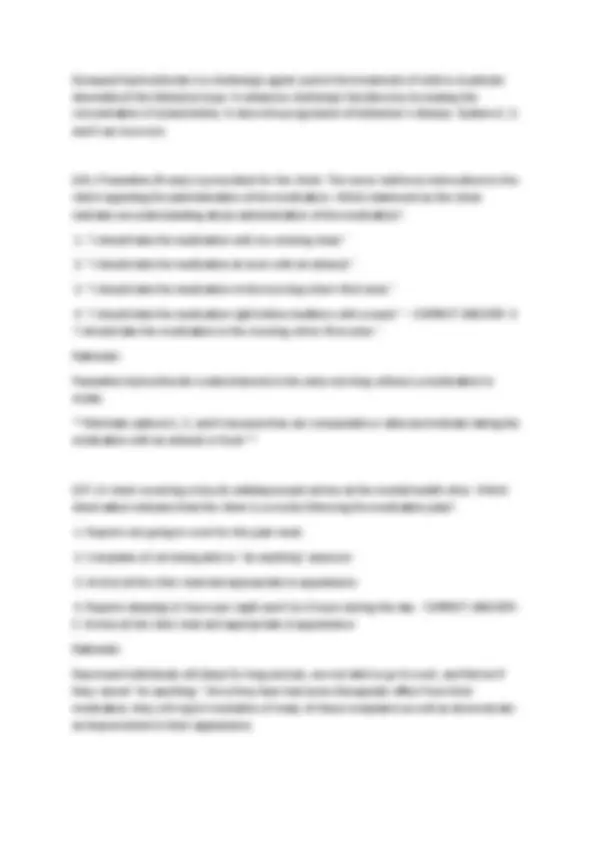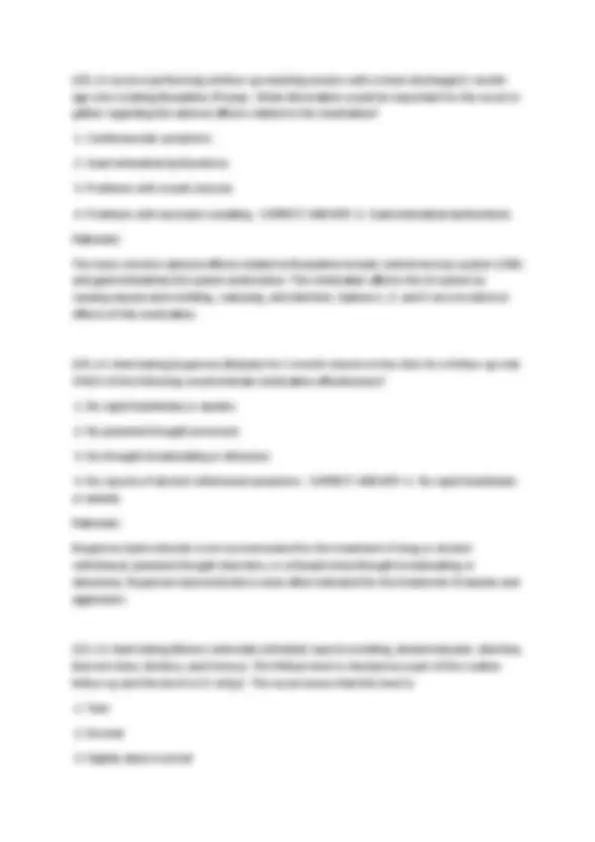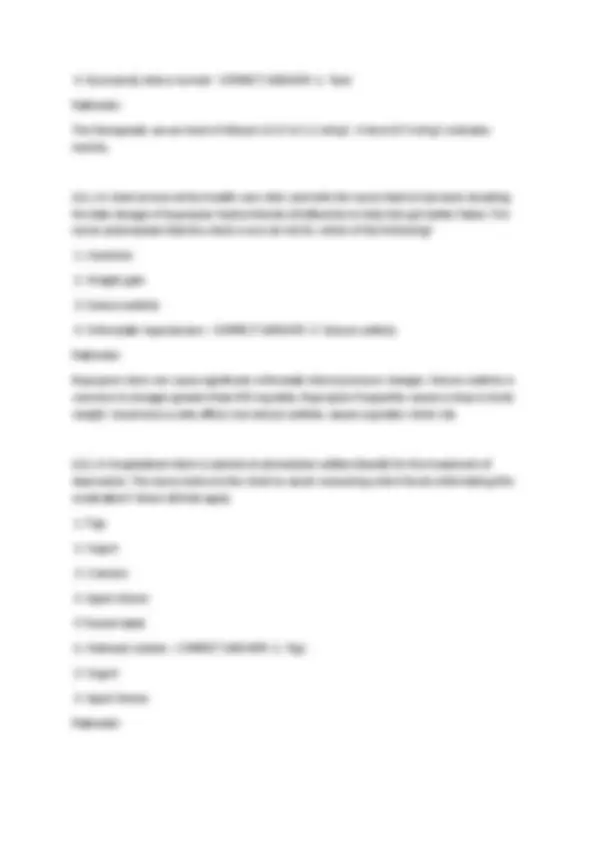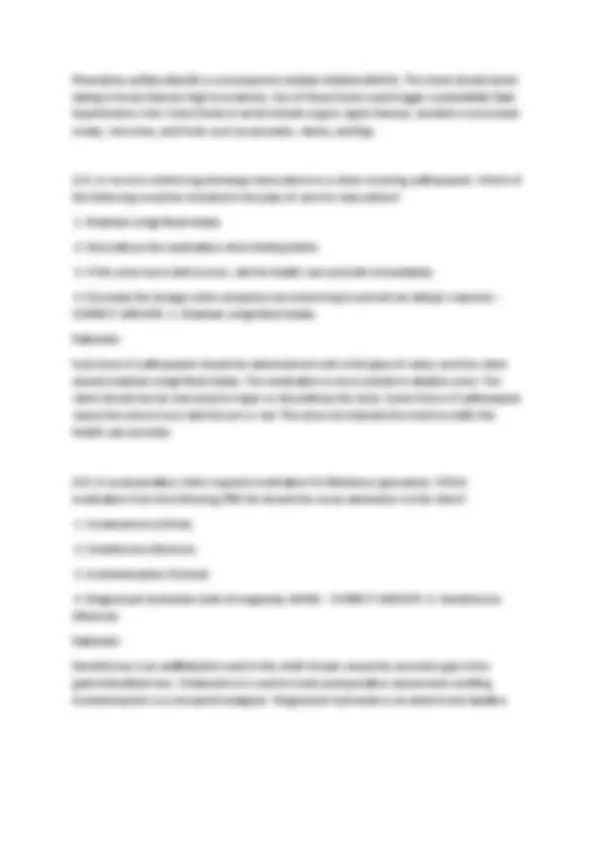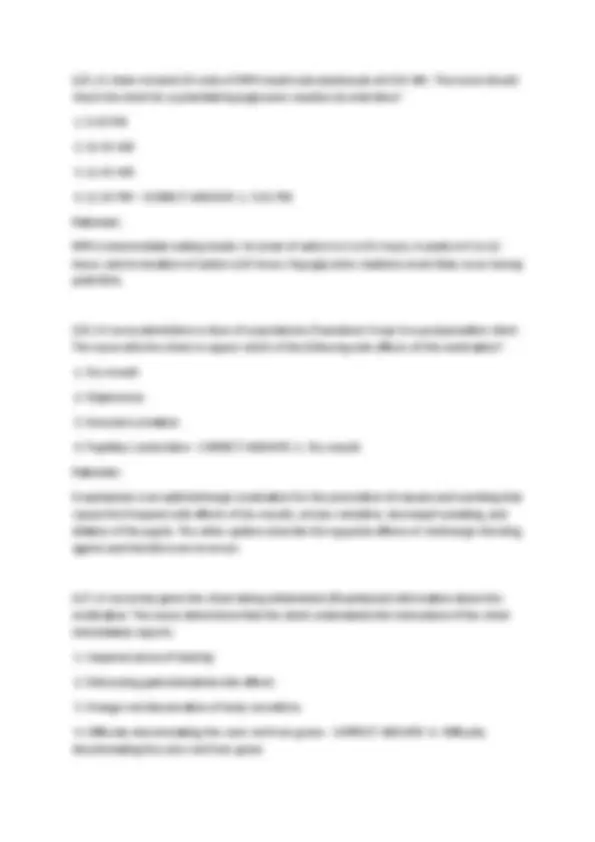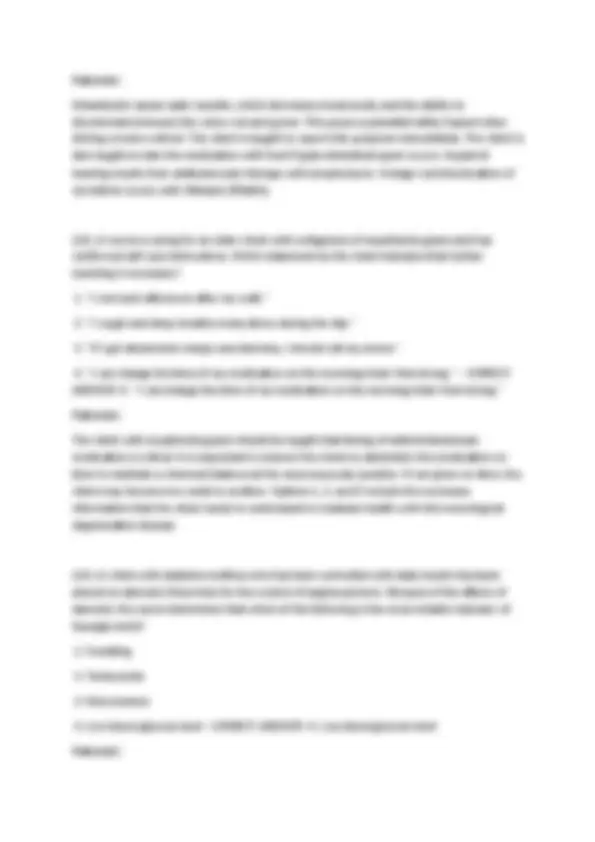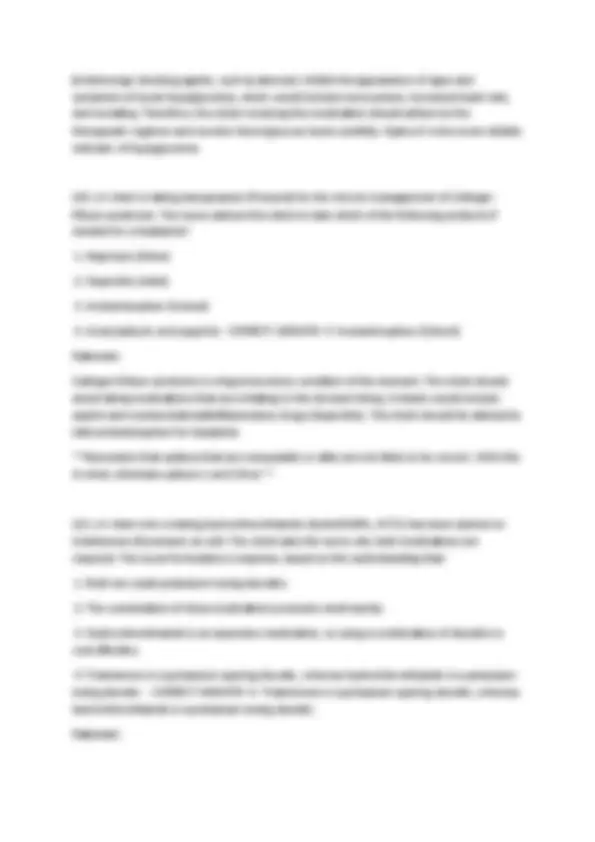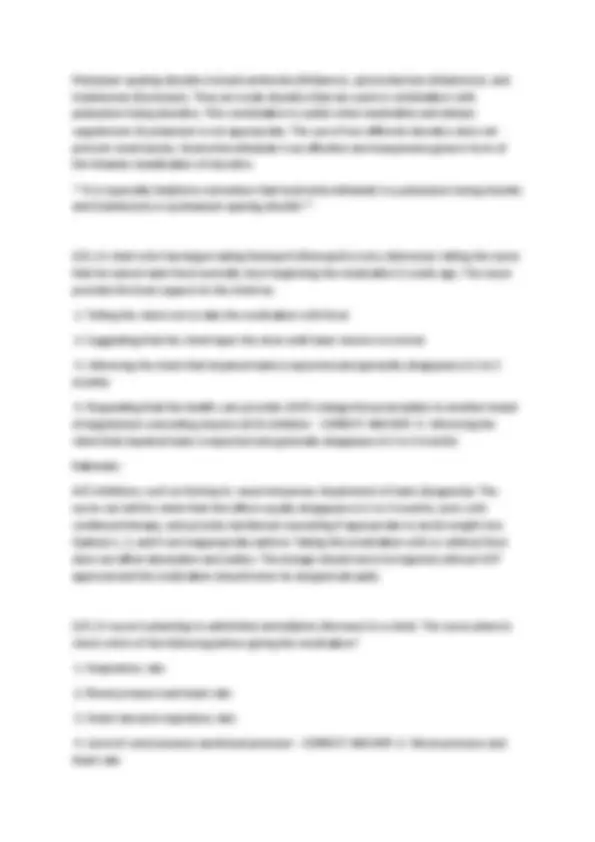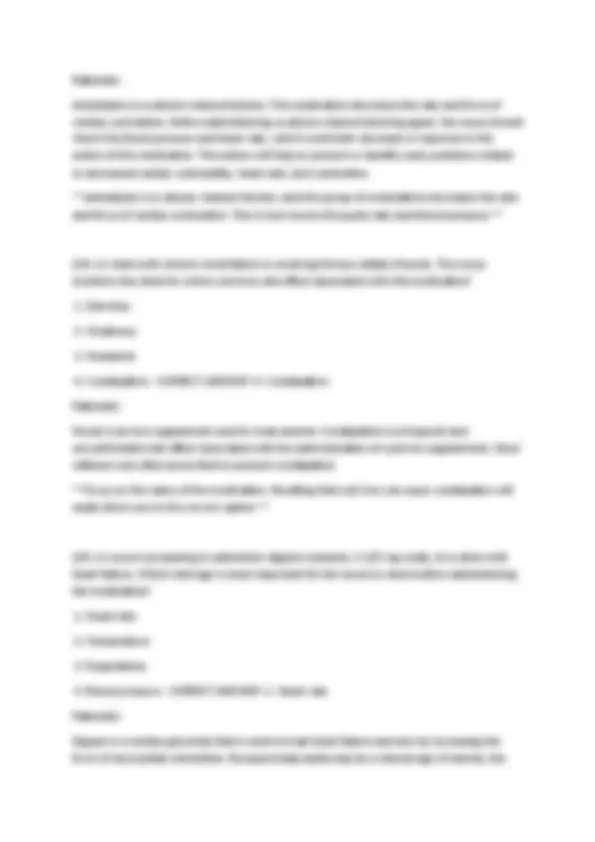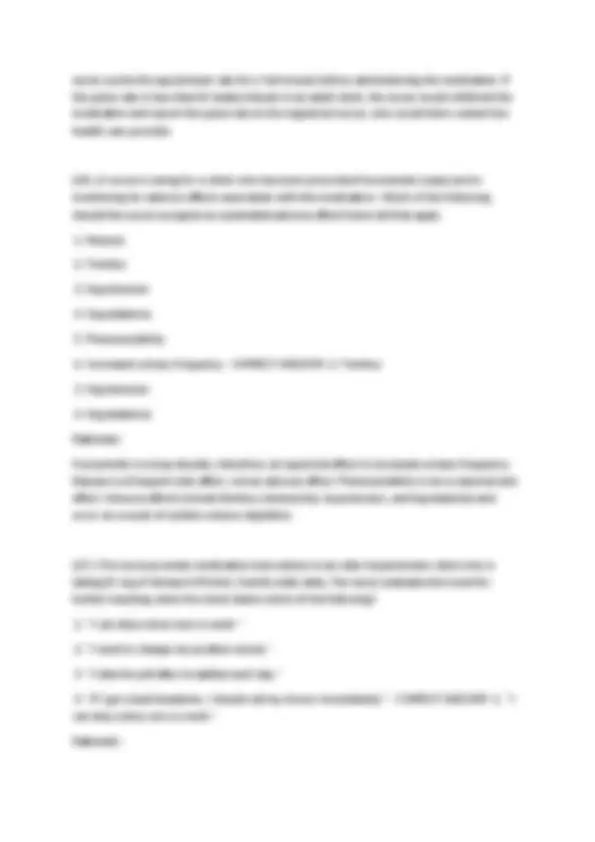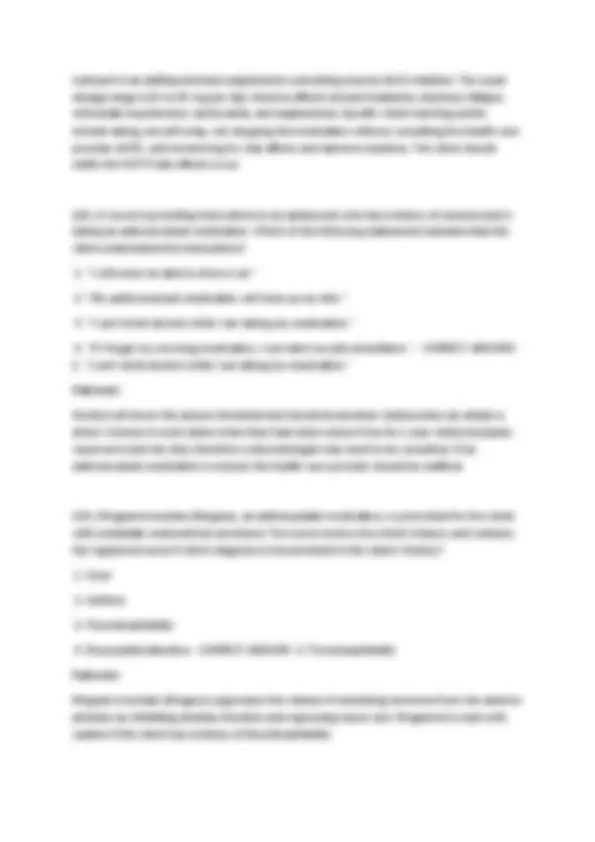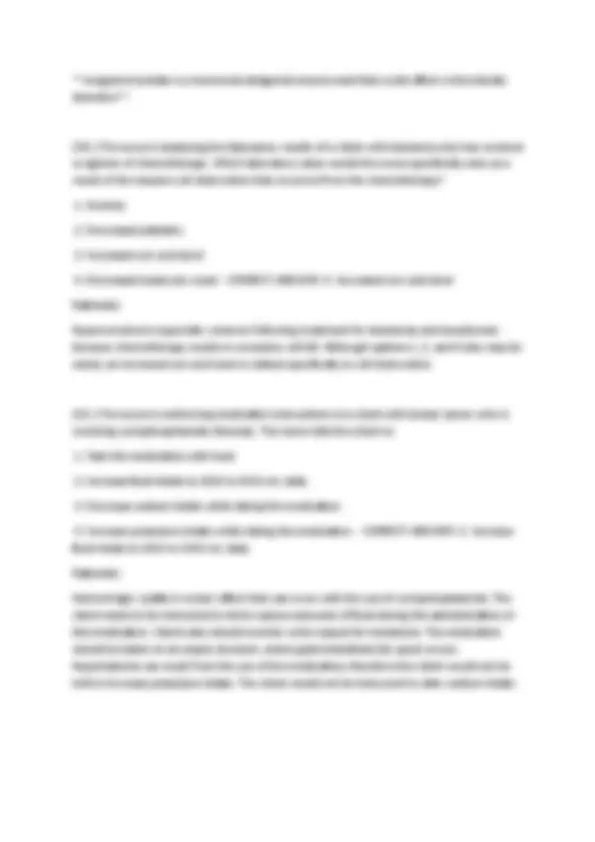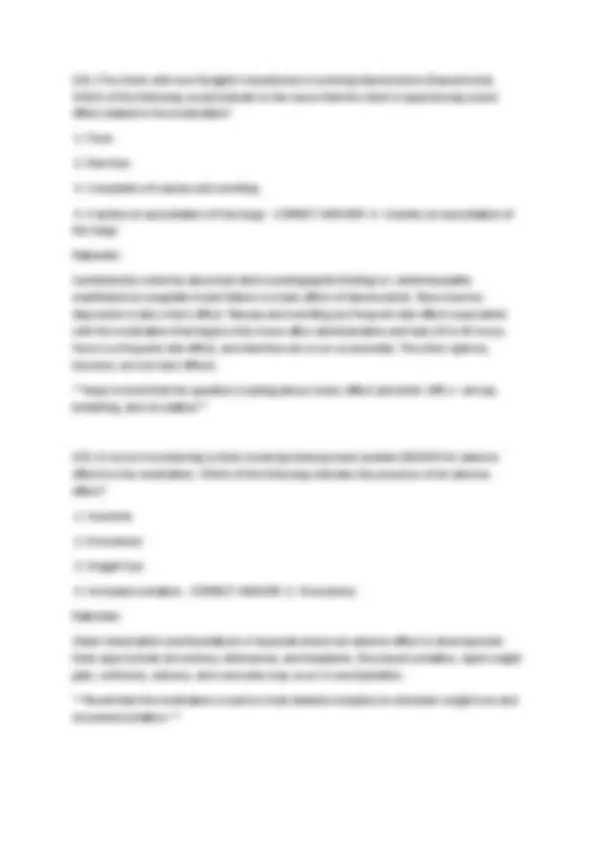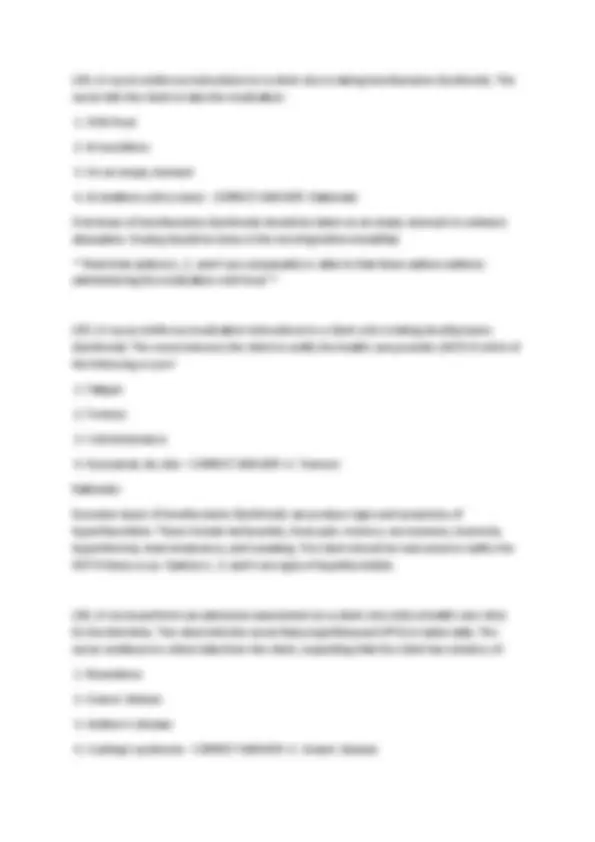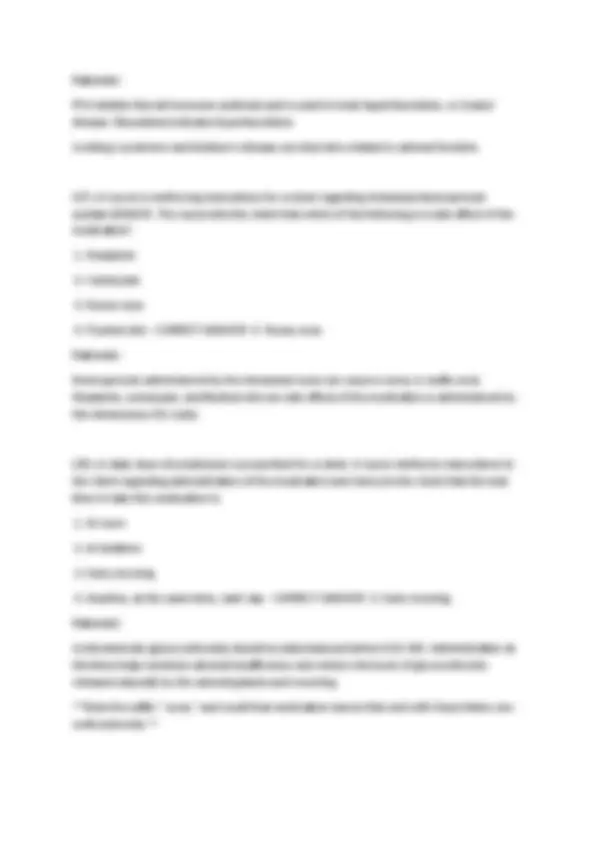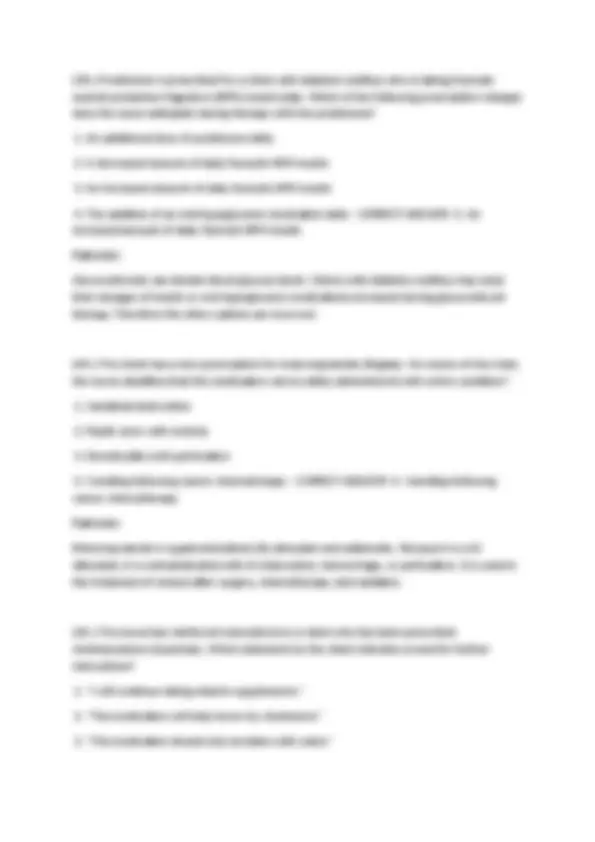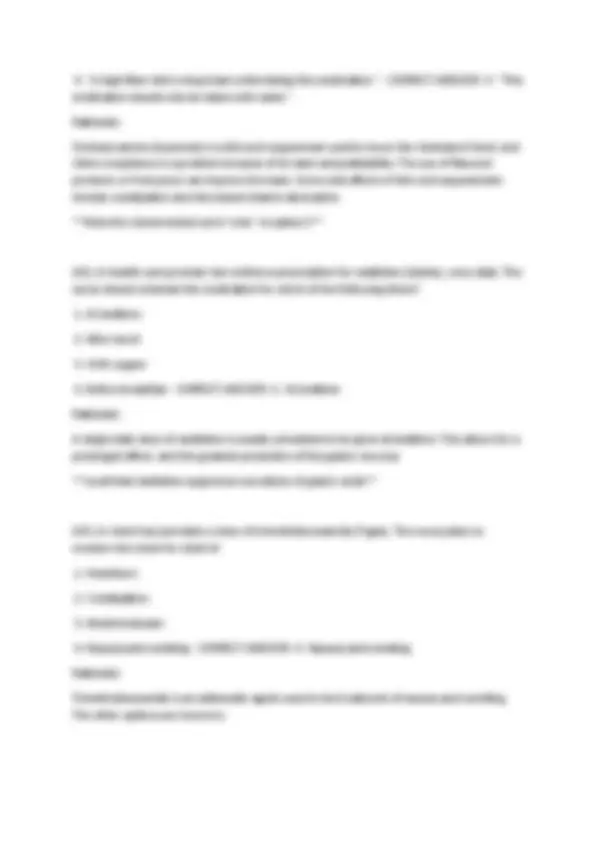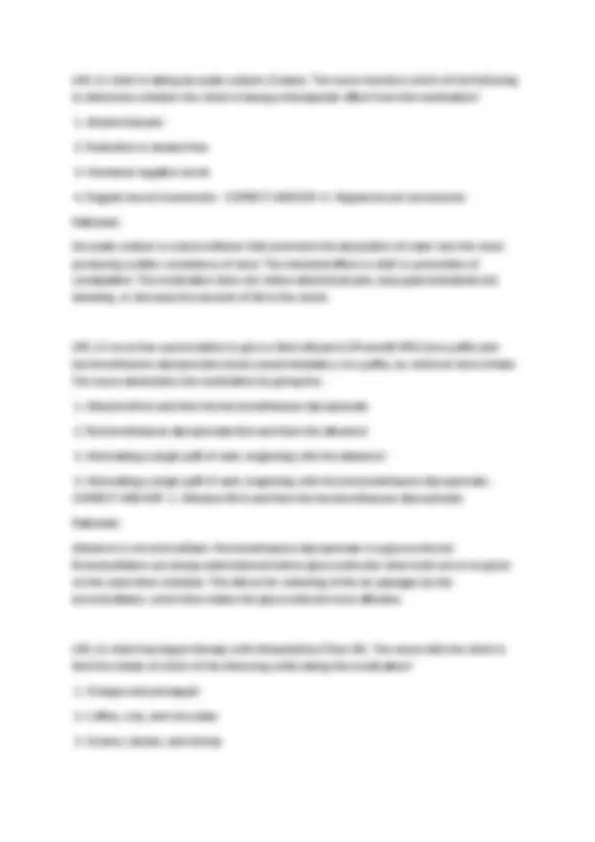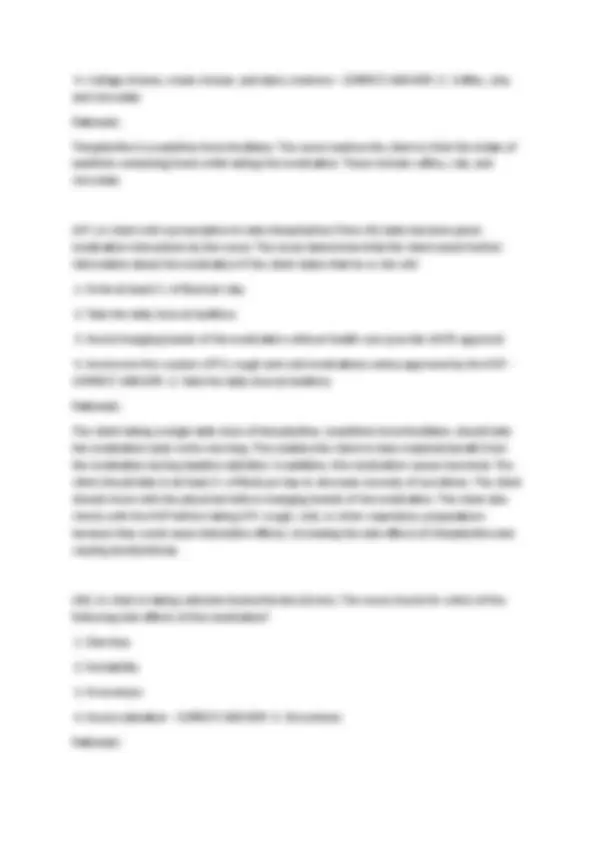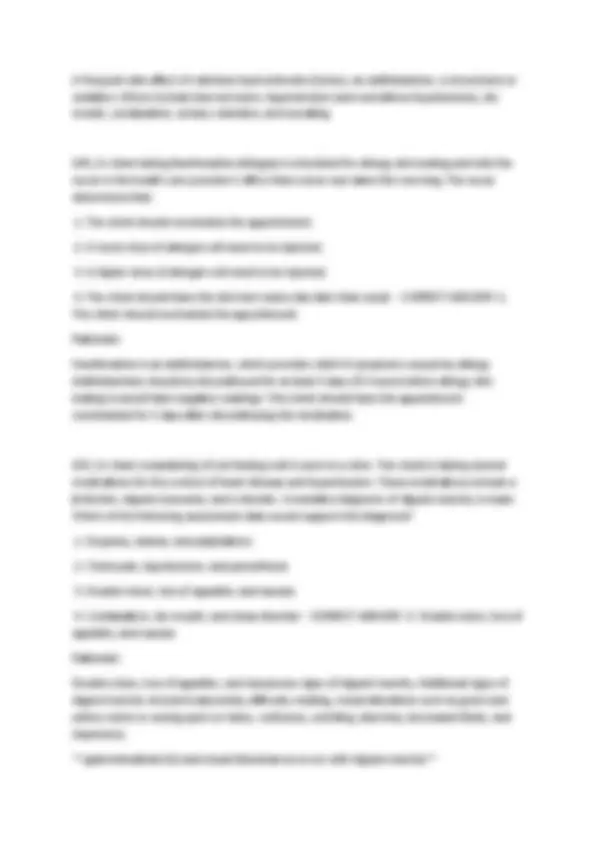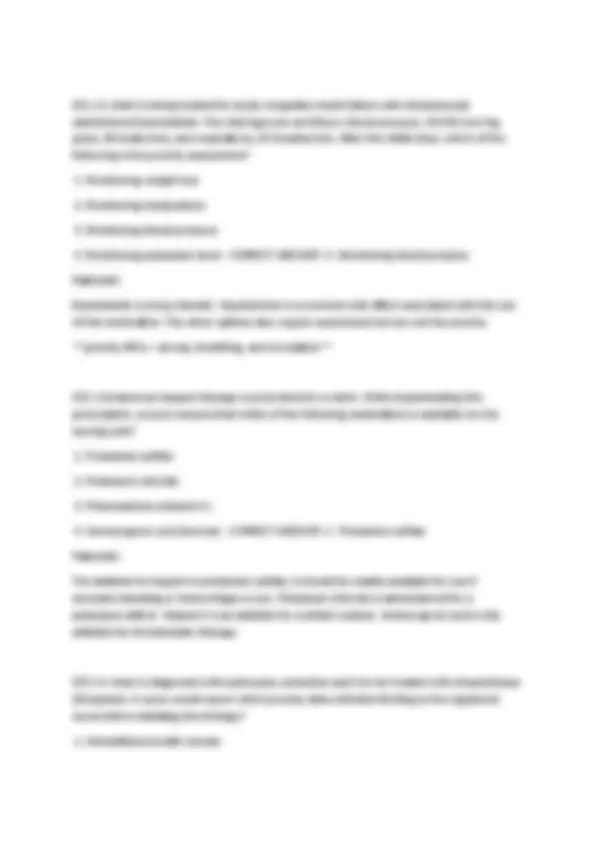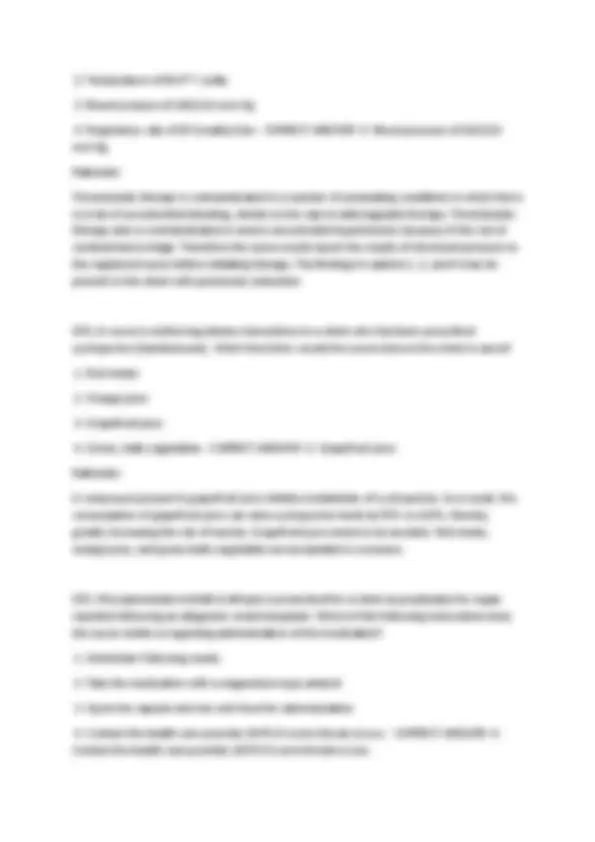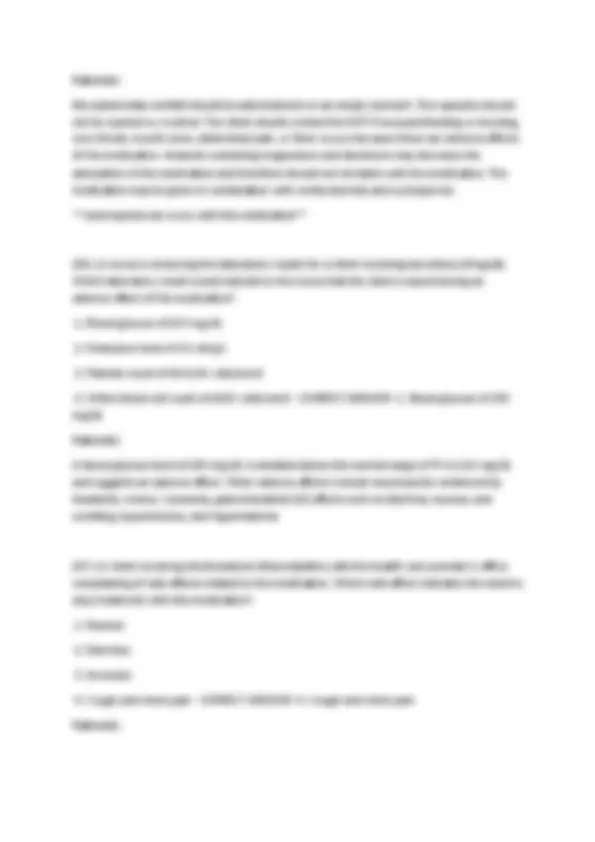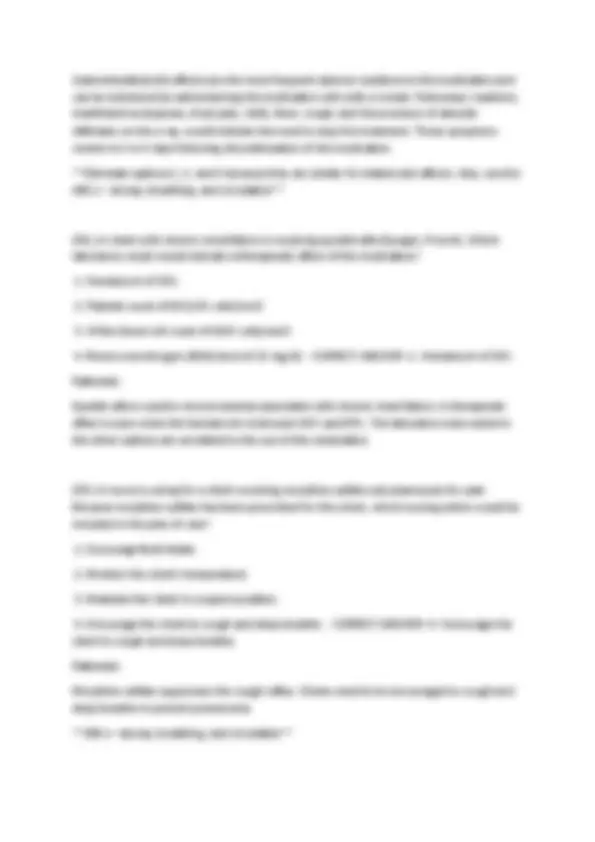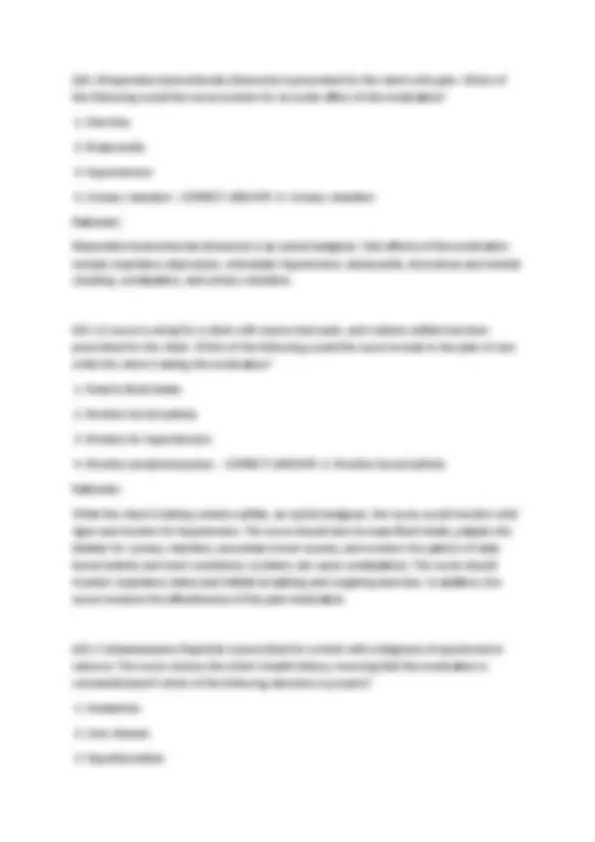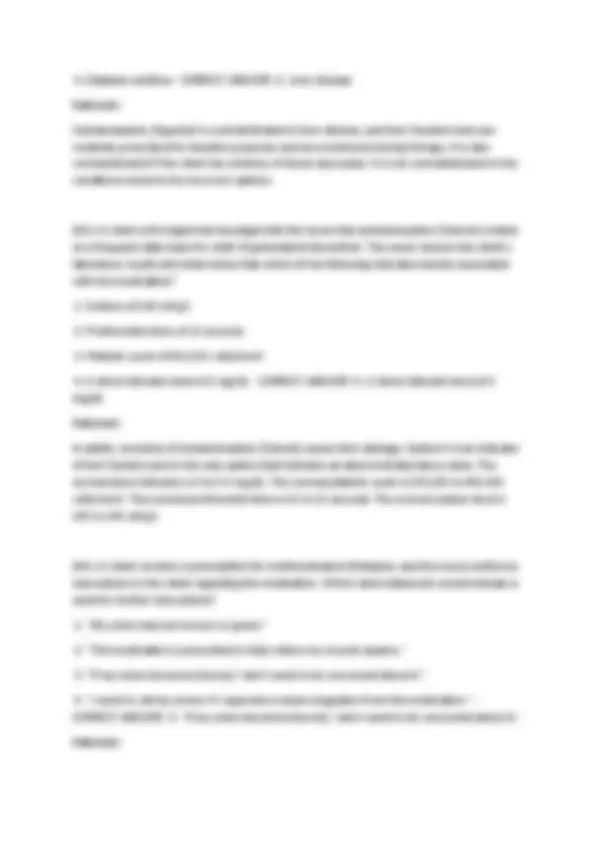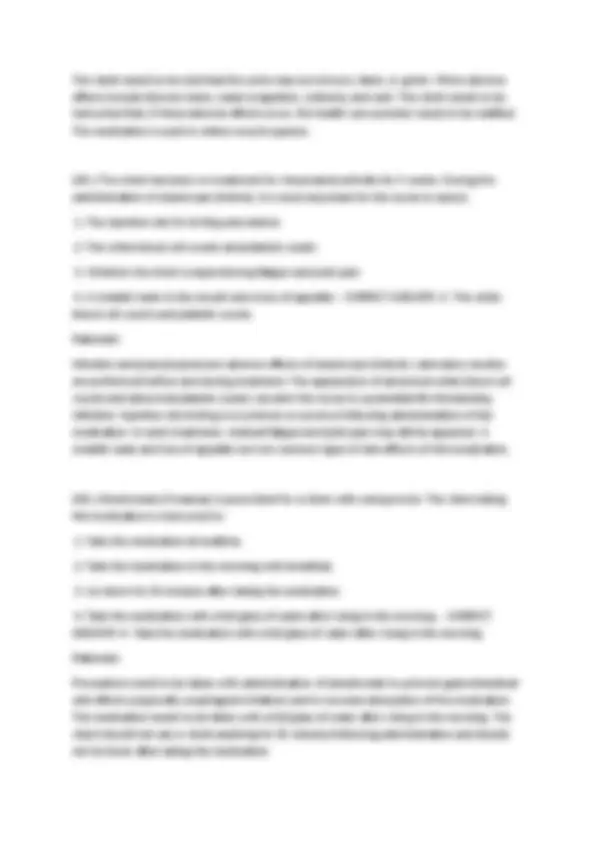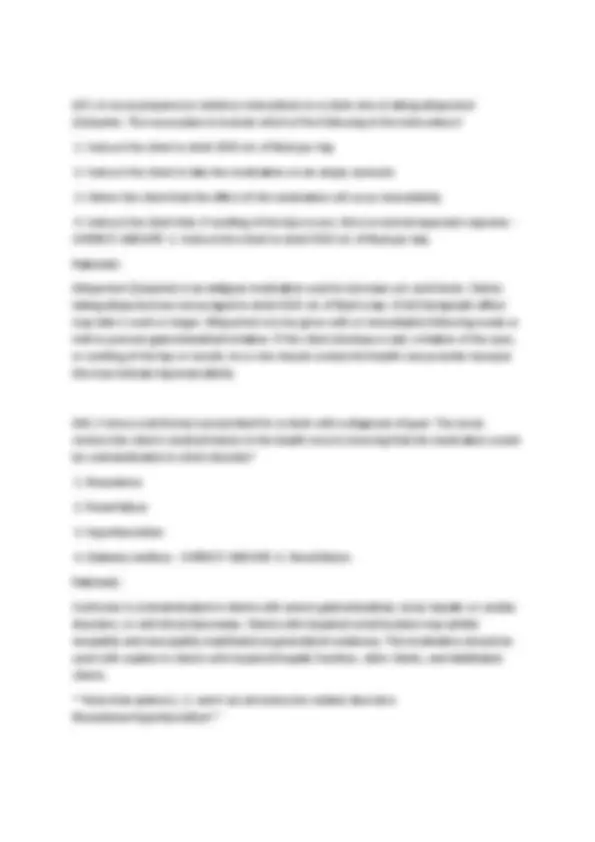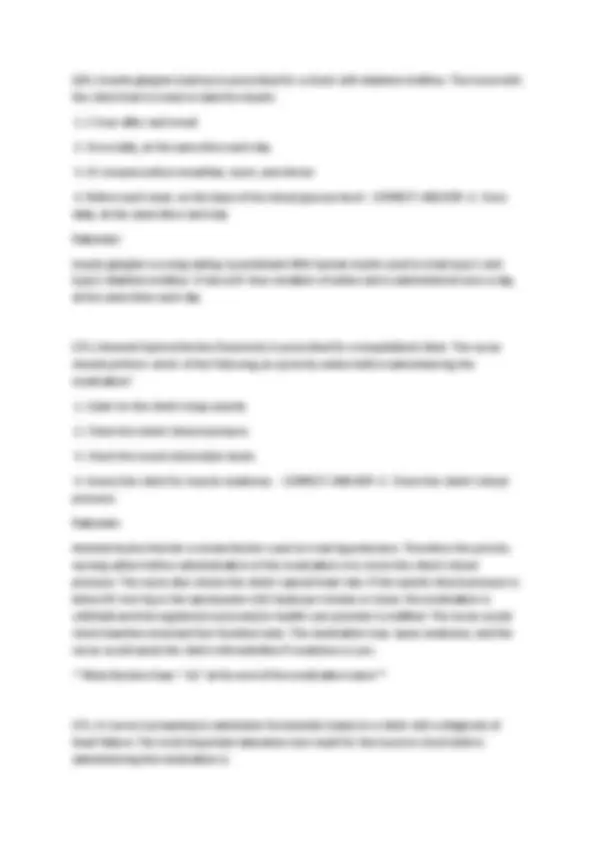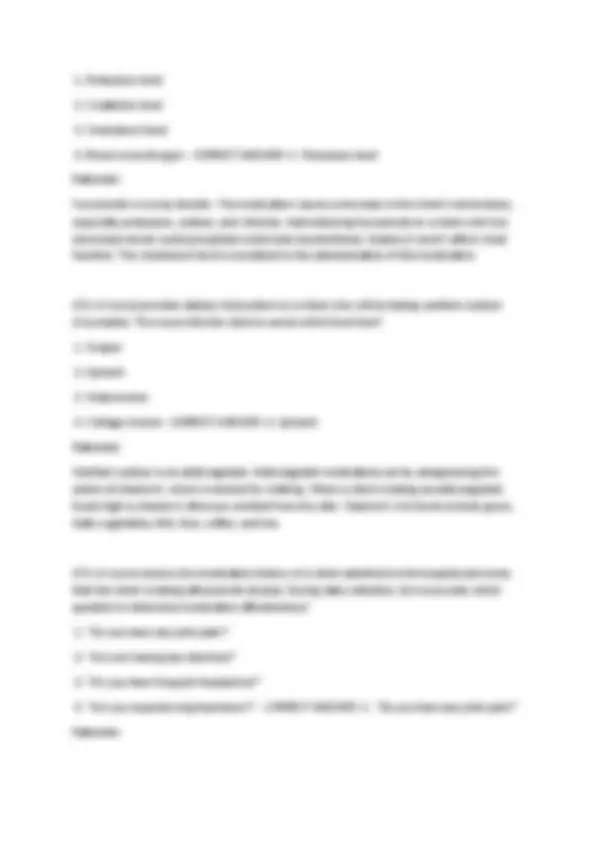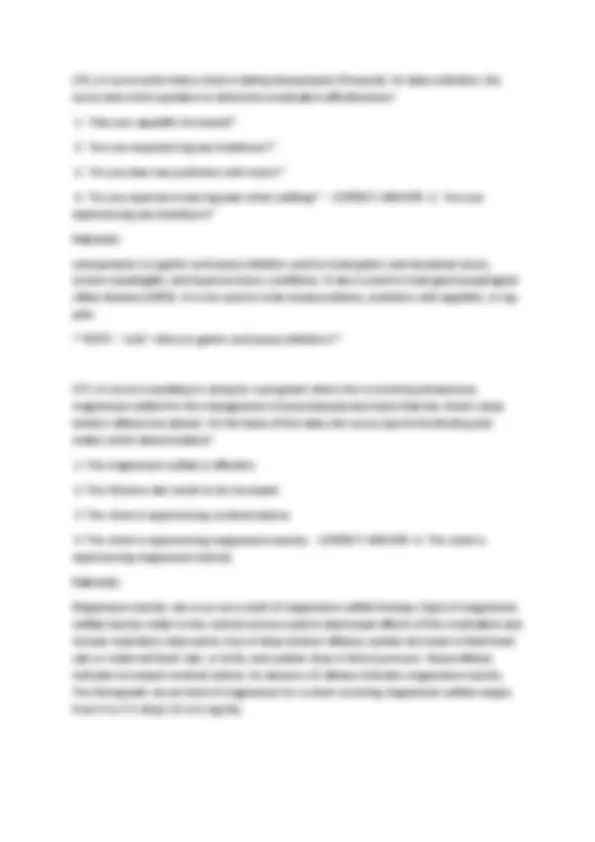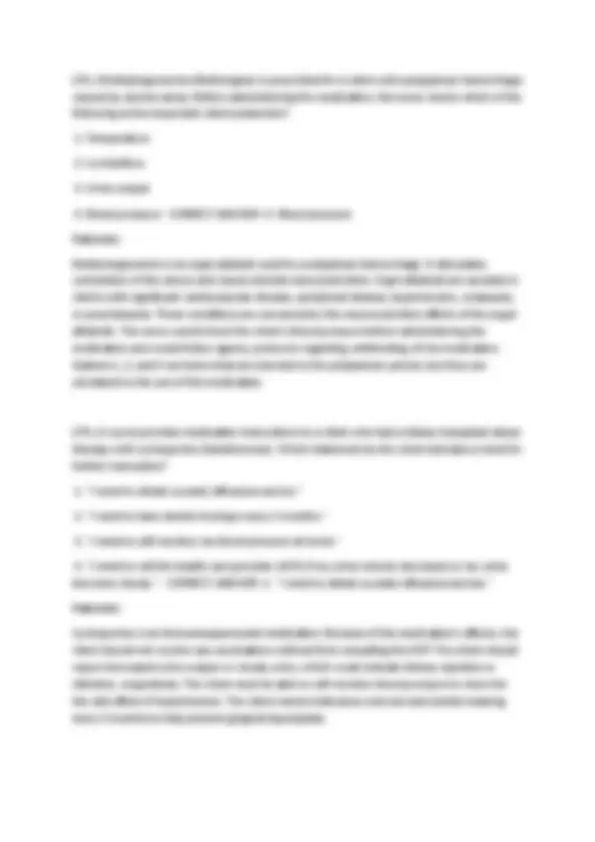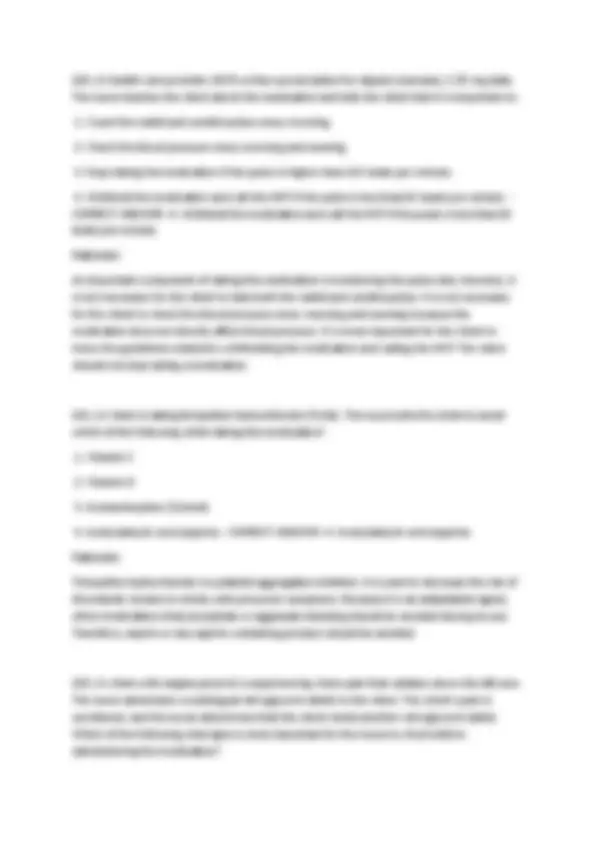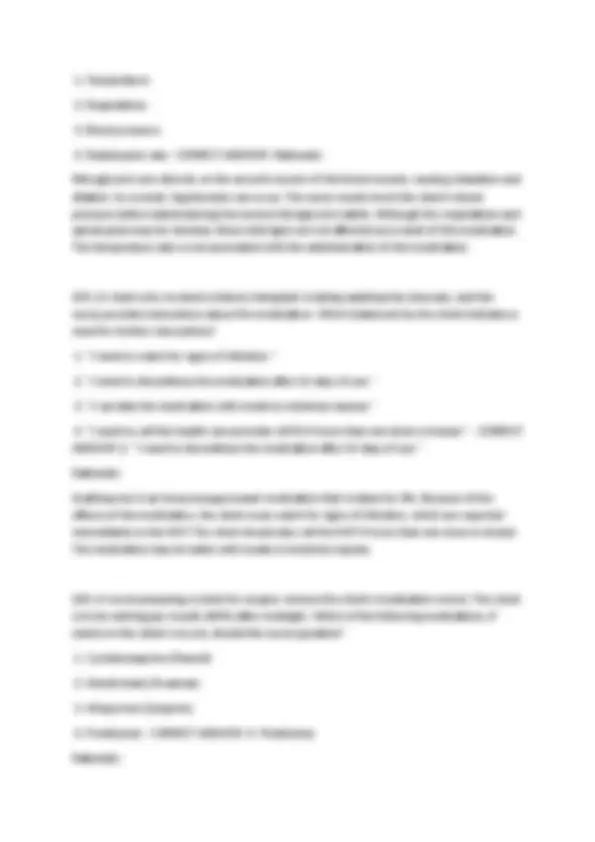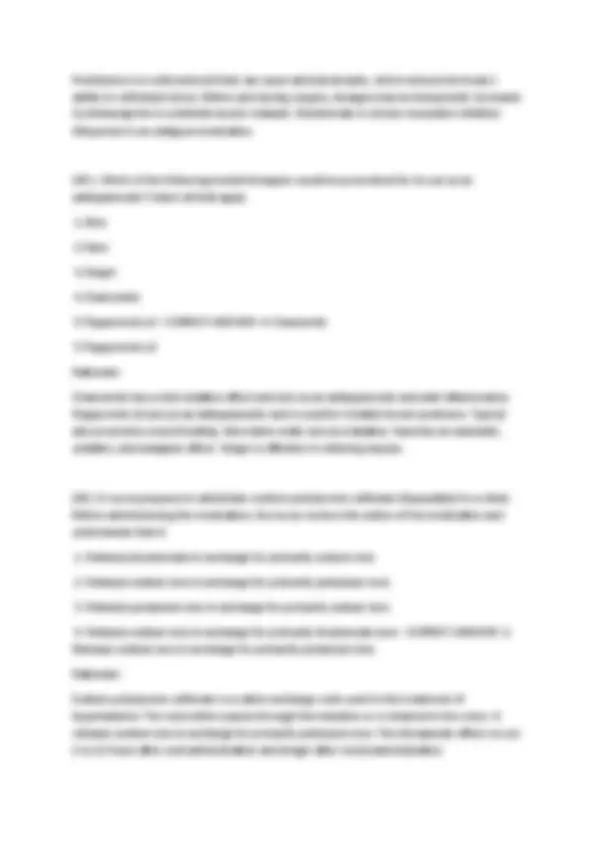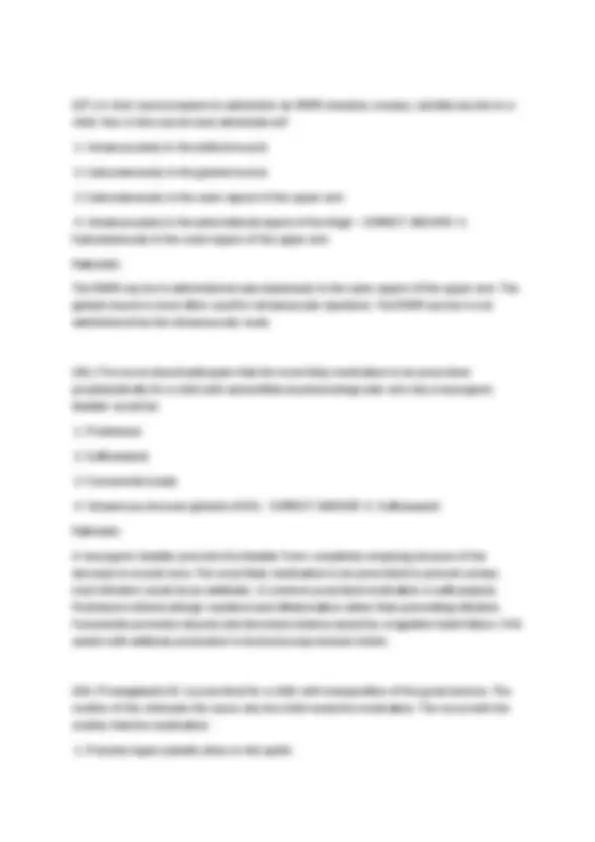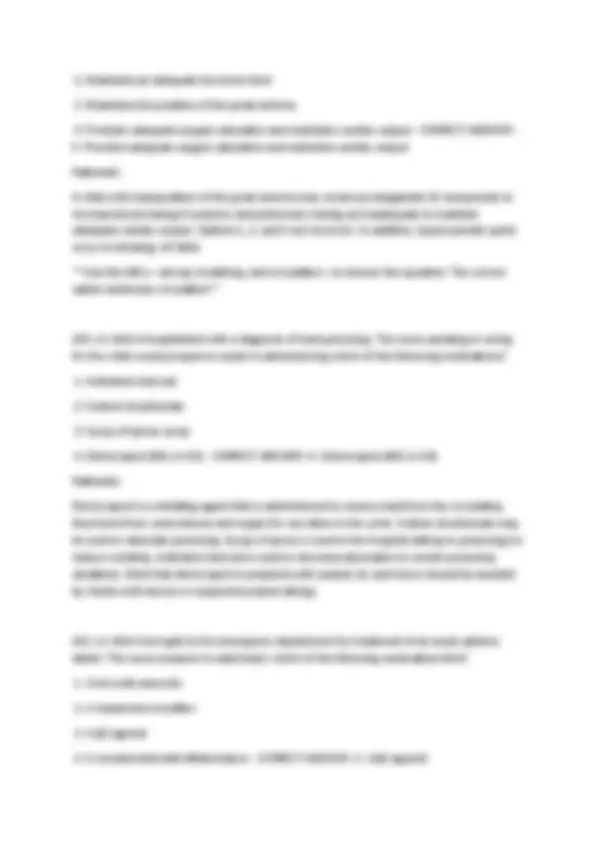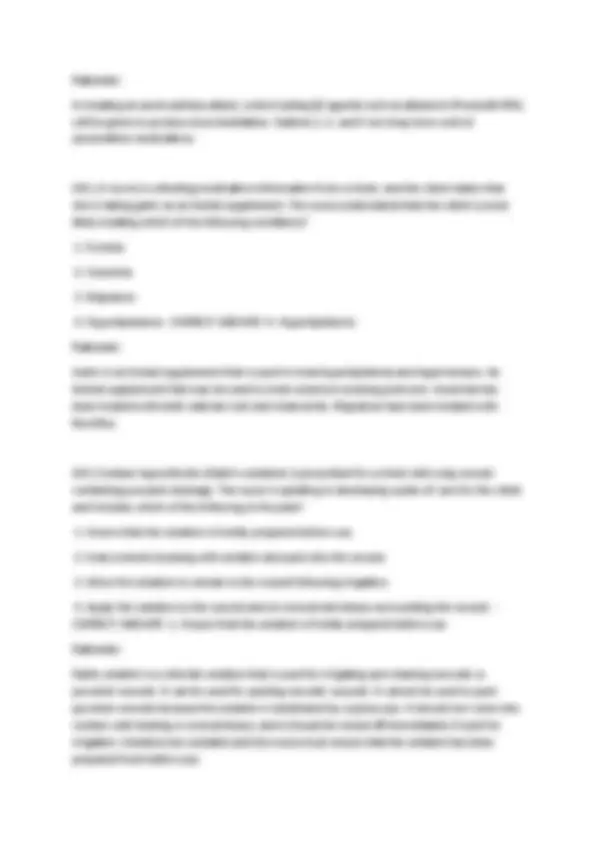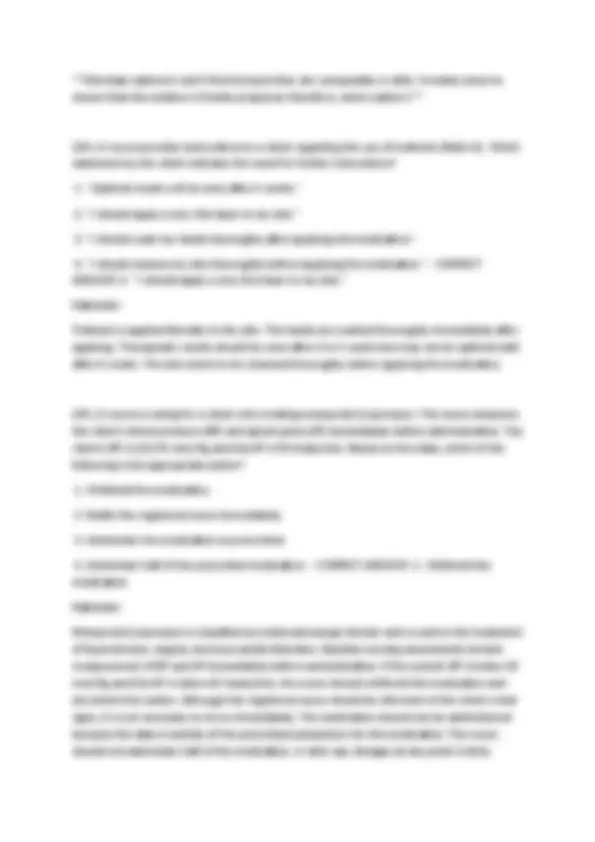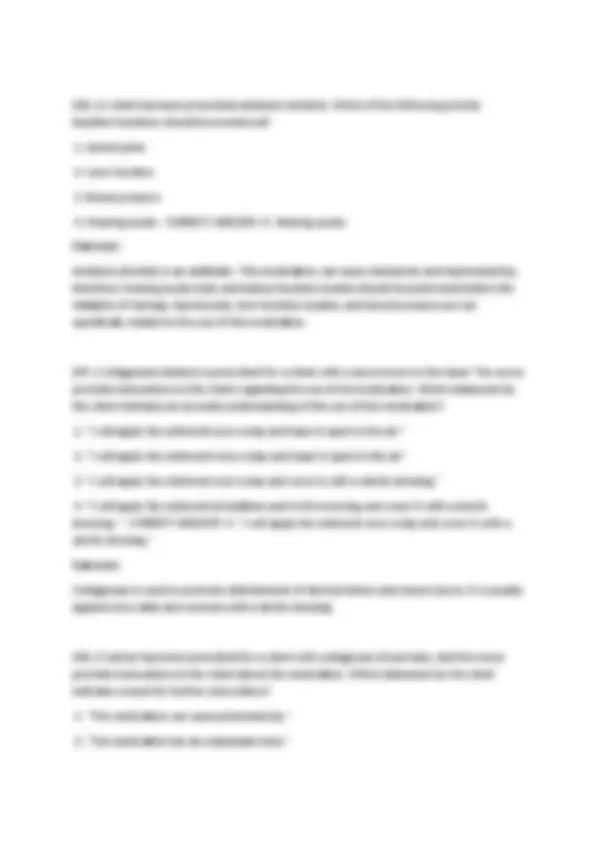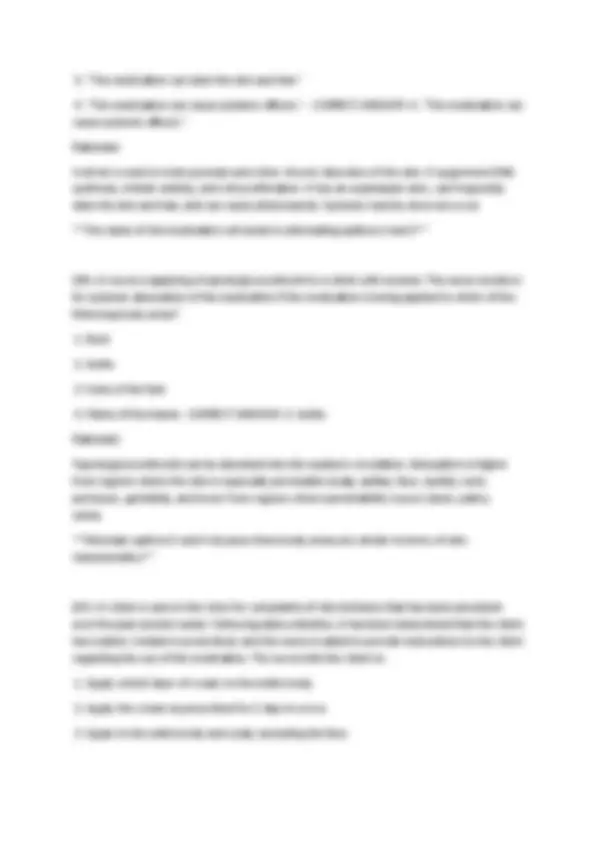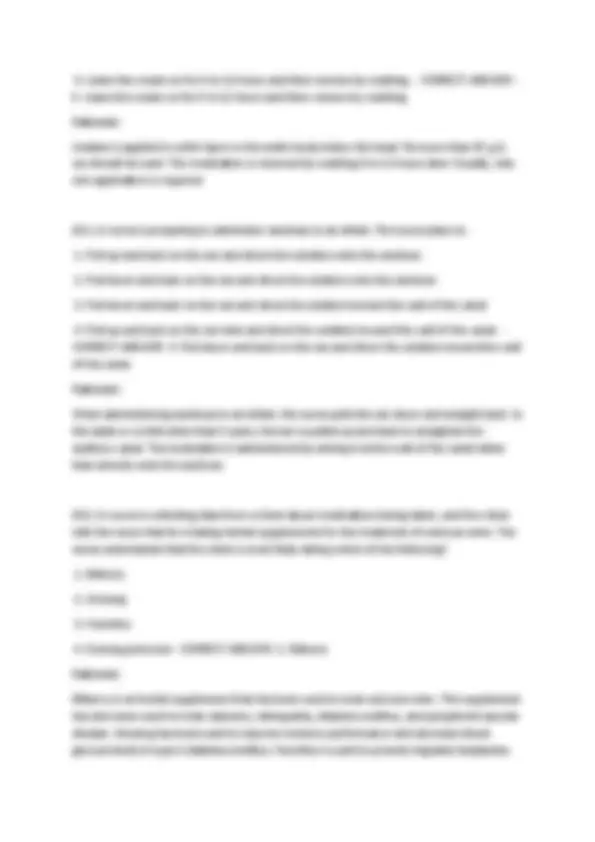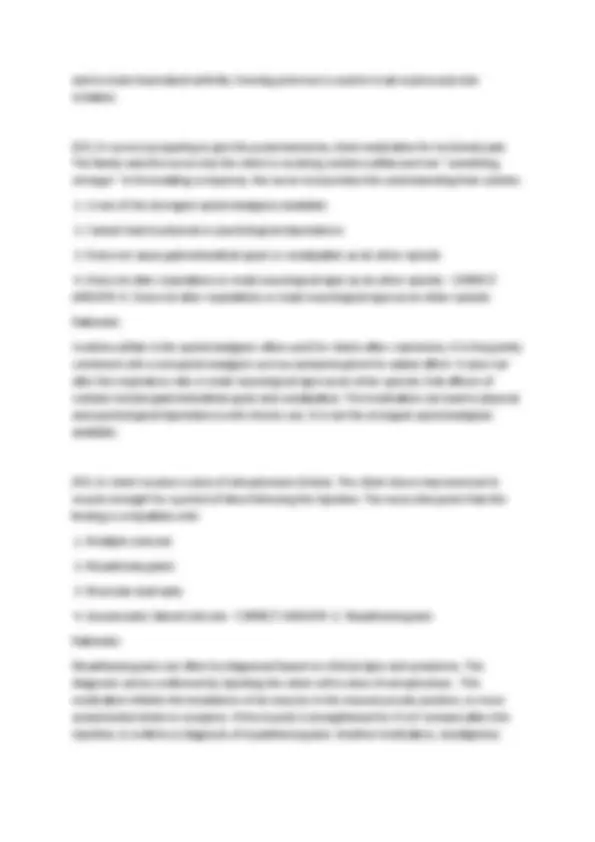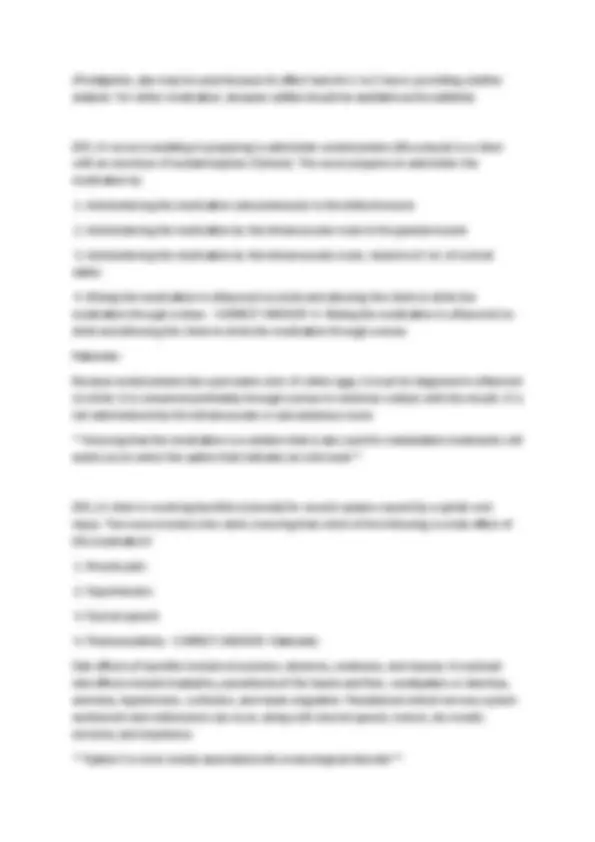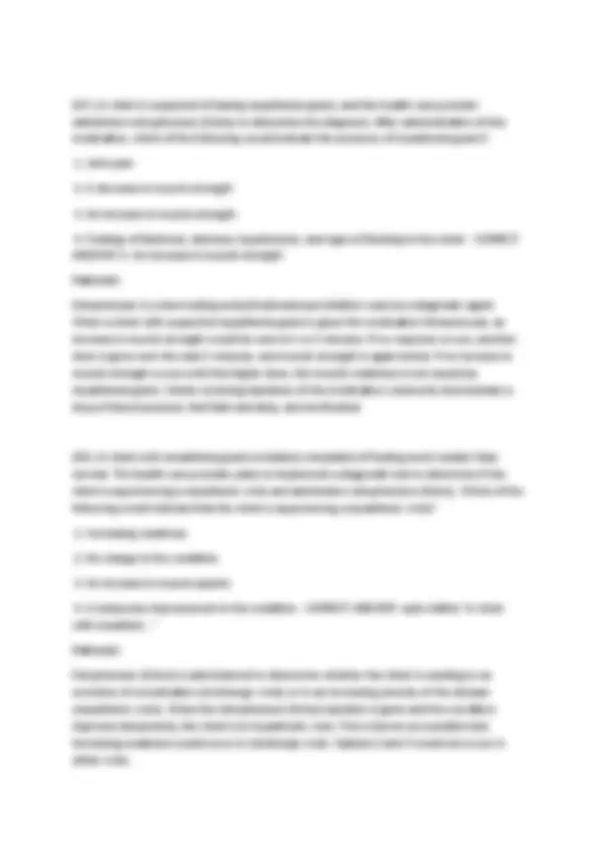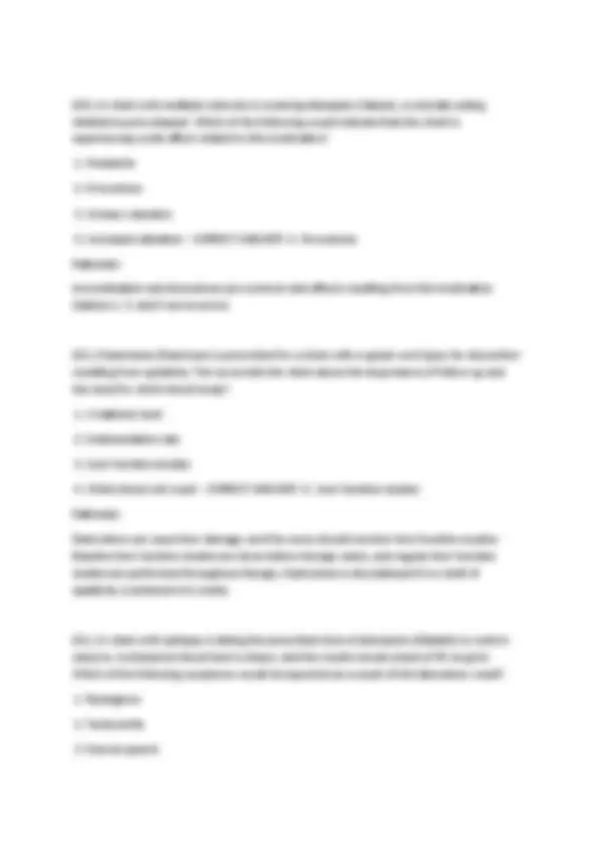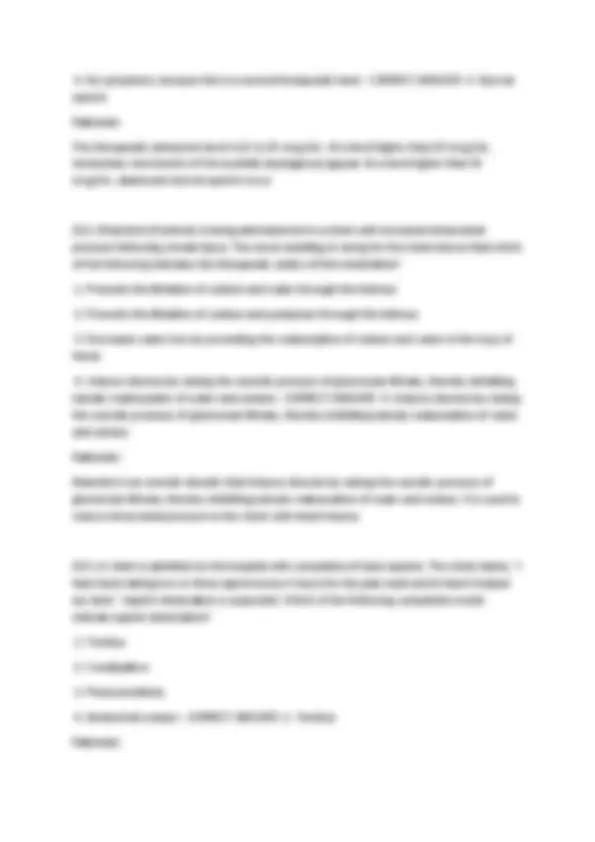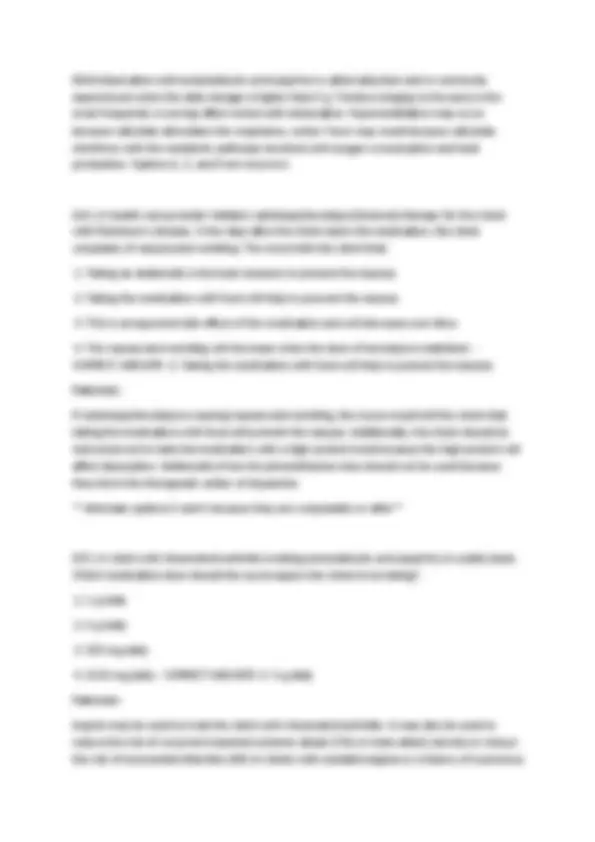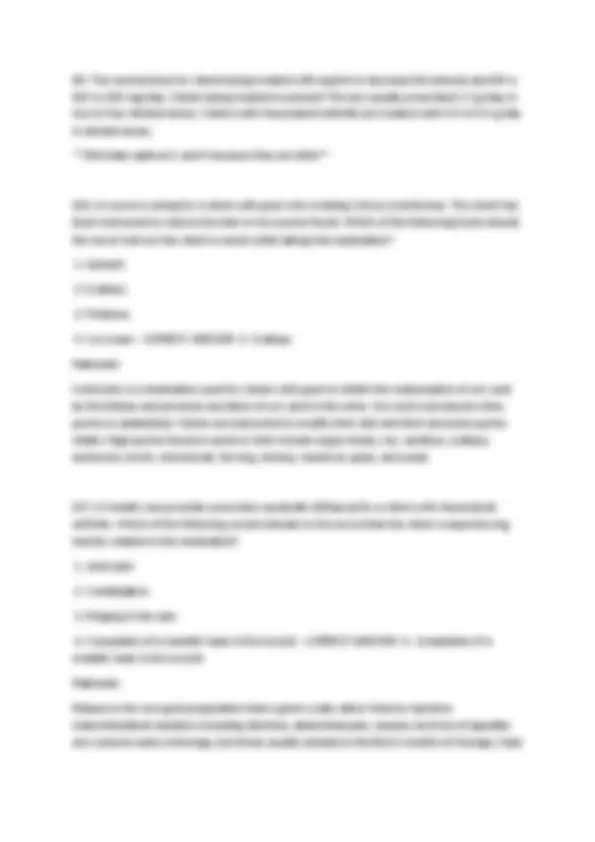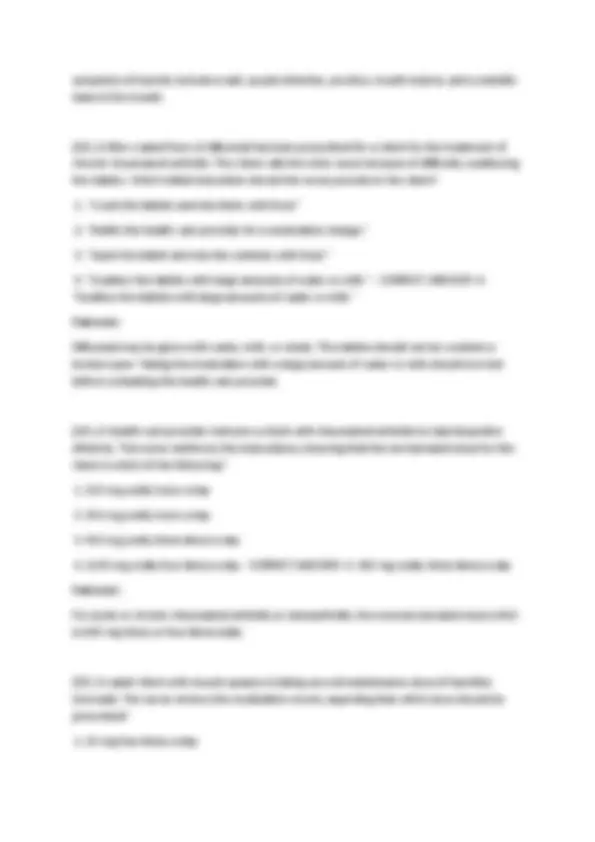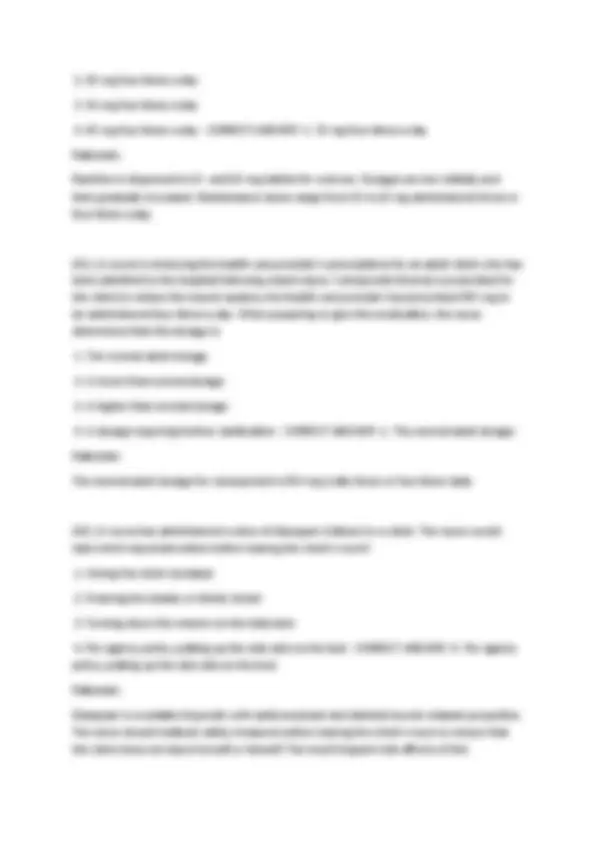Download HESI PHARMACOLOGY EXAM PRACTICE 2025 (NCLEX PN) 2 VERSIONS ACTUAL EXAM COMPLETE 300 QUE and more Exams Nursing in PDF only on Docsity!
HESI PHARMACOLOGY EXAM
PRACTICE 2025 (NCLEX PN) 2
VERSIONS ACTUAL EXAM
COMPLETE 300 QUESTIONS WITH
DETAILED VERIFIED ANSWERS AND
RATIONALES (100% CORRECT
ANSWERS) /ALREADY GRADED A+
- A nurse is caring for a client with hyperparathyroidism and notes that the client's serum calcium level is 13 mg/dL. Which medication should the nurse prepare to administer as prescribed to the client?
- Calcium chloride
- Calcium gluconate
- Calcitonin (Miacalcin)
- Large doses of vitamin D - CORRECT ANSWER - 3. Calcitonin (Miacalcin) Rationale: The normal serum calcium level is 8.6 to 10.0 mg/dL. This client is experiencing hypercalcemia. Calcium gluconate and calcium chloride are medications used for the treatment of tetany, which occurs as a result of acute hypocalcemia. In hypercalcemia, large doses of vitamin D need to be avoided. Calcitonin, a thyroid hormone, decreases the plasma calcium level by inhibiting bone resorption and lowering the serum calcium concentration. 2.) Oral iron supplements are prescribed for a 6-year-old child with iron deficiency anemia. The nurse instructs the mother to administer the iron with which best food item?
- Milk
- Water
- Apple juice
- Orange juice - CORRECT ANSWER - 4. Orange juice Rationale:
Vitamin C increases the absorption of iron by the body. The mother should be instructed to administer the medication with a citrus fruit or a juice that is high in vitamin C. Milk may affect absorption of the iron. Water will not assist in absorption. Orange juice contains a greater amount of vitamin C than apple juice. 3.) Salicylic acid is prescribed for a client with a diagnosis of psoriasis. The nurse monitors the client, knowing that which of the following would indicate the presence of systemic toxicity from this medication?
- Tinnitus
- Diarrhea
- Constipation
- Decreased respirations - CORRECT ANSWER - 1. Tinnitus Rationale: Salicylic acid is absorbed readily through the skin, and systemic toxicity (salicylism) can result. Symptoms include tinnitus, dizziness, hyperpnea, and psychological disturbances. Constipation and diarrhea are not associated with salicylism. 4.) The camp nurse asks the children preparing to swim in the lake if they have applied sunscreen. The nurse reminds the children that chemical sunscreens are most effective when applied:
- Immediately before swimming
- 15 minutes before exposure to the sun
- Immediately before exposure to the sun
- At least 30 minutes before exposure to the sun - CORRECT ANSWER - 4. At least 30 minutes before exposure to the sun Rationale: Sunscreens are most effective when applied at least 30 minutes before exposure to the sun so that they can penetrate the skin. All sunscreens should be reapplied after swimming or sweating.
- Complete blood count
- White blood cell count - CORRECT ANSWER - 2. Triglyceride level Rationale: Isotretinoin can elevate triglyceride levels. Blood triglyceride levels should be measured before treatment and periodically thereafter until the effect on the triglycerides has been evaluated. Options 1, 3, and 4 do not need to be monitored specifically during this treatment. 8.) A client with severe acne is seen in the clinic and the health care provider (HCP) prescribes isotretinoin. The nurse reviews the client's medication record and would contact the (HCP) if the client is taking which medication?
- Vitamin A
- Digoxin (Lanoxin)
- Furosemide (Lasix)
- Phenytoin (Dilantin) - CORRECT ANSWER - 1. Vitamin A Rationale: Isotretinoin is a metabolite of vitamin A and can produce generalized intensification of isotretinoin toxicity. Because of the potential for increased toxicity, vitamin A supplements should be discontinued before isotretinoin therapy. Options 2, 3, and 4 are not contraindicated with the use of isotretinoin. 9.) The nurse is applying a topical corticosteroid to a client with eczema. The nurse would monitor for the potential for increased systemic absorption of the medication if the medication were being applied to which of the following body areas?
- Back
- Axilla
- Soles of the feet
- Palms of the hands - CORRECT ANSWER - 2. Axilla Rationale: Topical corticosteroids can be absorbed into the systemic circulation. Absorption is higher from regions where the skin is especially permeable (scalp, axilla, face, eyelids, neck,
perineum, genitalia), and lower from regions in which permeability is poor (back, palms, soles). 10.) The clinic nurse is performing an admission assessment on a client. The nurse notes that the client is taking azelaic acid (Azelex). Because of the medication prescription, the nurse would suspect that the client is being treated for:
- Acne
- Eczema
- Hair loss
- Herpes simplex - CORRECT ANSWER - 1. Acne Rationale: Azelaic acid is a topical medication used to treat mild to moderate acne. The acid appears to work by suppressing the growth of Propionibacterium acnes and decreasing the proliferation of keratinocytes. Options 2, 3, and 4 are incorrect. 11.) The health care provider has prescribed silver sulfadiazine (Silvadene) for the client with a partial-thickness burn, which has cultured positive for gram-negative bacteria. The nurse is reinforcing information to the client about the medication. Which statement made by the client indicates a lack of understanding about the treatments?
- "The medication is an antibacterial."
- "The medication will help heal the burn."
- "The medication will permanently stain my skin."
- "The medication should be applied directly to the wound." - CORRECT ANSWER - 3. "The medication will permanently stain my skin." Rationale: Silver sulfadiazine (Silvadene) is an antibacterial that has a broad spectrum of activity against gram-negative bacteria, gram-positive bacteria, and yeast. It is applied directly to the wound to assist in healing. It does not stain the skin. 12.) A nurse is caring for a client who is receiving an intravenous (IV) infusion of an antineoplastic medication. During the infusion, the client complains of pain at the insertion
- Clotting time
- Uric acid level
- Potassium level
- Blood glucose level - CORRECT ANSWER - 2. Uric acid level Rationale: Busulfan (Myleran) can cause an increase in the uric acid level. Hyperuricemia can produce uric acid nephropathy, renal stones, and acute renal failure. Options 1, 3, and 4 are not specifically related to this medication. 15.) The client with small cell lung cancer is being treated with etoposide (VePesid). The nurse who is assisting in caring for the client during its administration understands that which side effect is specifically associated with this medication?
- Alopecia
- Chest pain
- Pulmonary fibrosis
- Orthostatic hypotension - CORRECT ANSWER - 4. Orthostatic hypotension Rationale: A side effect specific to etoposide is orthostatic hypotension. The client's blood pressure is monitored during the infusion. Hair loss occurs with nearly all the antineoplastic medications. Chest pain and pulmonary fibrosis are unrelated to this medication. 16.) The clinic nurse is reviewing a teaching plan for the client receiving an antineoplastic medication. When implementing the plan, the nurse tells the client:
- To take aspirin (acetylsalicylic acid) as needed for headache
- Drink beverages containing alcohol in moderate amounts each evening
- Consult with health care providers (HCPs) before receiving immunizations
- That it is not necessary to consult HCPs before receiving a flu vaccine at the local health fair - CORRECT ANSWER - 3. Consult with health care providers (HCPs) before receiving immunizations Rationale:
Because antineoplastic medications lower the resistance of the body, clients must be informed not to receive immunizations without a HCP's approval. Clients also need to avoid contact with individuals who have recently received a live virus vaccine. Clients need to avoid aspirin and aspirin-containing products to minimize the risk of bleeding, and they need to avoid alcohol to minimize the risk of toxicity and side effects. 17.) The client with ovarian cancer is being treated with vincristine (Oncovin). The nurse monitors the client, knowing that which of the following indicates a side effect specific to this medication?
- Diarrhea
- Hair loss
- Chest pain
- Numbness and tingling in the fingers and toes - CORRECT ANSWER - 4. Numbness and tingling in the fingers and toes Rationale: A side effect specific to vincristine is peripheral neuropathy, which occurs in almost every client. Peripheral neuropathy can be manifested as numbness and tingling in the fingers and toes. Depression of the Achilles tendon reflex may be the first clinical sign indicating peripheral neuropathy. Constipation rather than diarrhea is most likely to occur with this medication, although diarrhea may occur occasionally. Hair loss occurs with nearly all the antineoplastic medications. Chest pain is unrelated to this medication. 18.) The nurse is reviewing the history and physical examination of a client who will be receiving asparaginase (Elspar), an antineoplastic agent. The nurse consults with the registered nurse regarding the administration of the medication if which of the following is documented in the client's history?
- Pancreatitis
- Diabetes mellitus
- Myocardial infarction
- Chronic obstructive pulmonary disease - CORRECT ANSWER - 1. Pancreatitis Rationale: Asparaginase (Elspar) is contraindicated if hypersensitivity exists, in pancreatitis, or if the client has a history of pancreatitis. The medication impairs pancreatic function and
excessive thirst, nausea, vomiting, constipation, hypotonicity of muscles, and deep bone and flank pain. 21.) A nurse is assisting with caring for a client with cancer who is receiving cisplatin. Select the adverse effects that the nurse monitors for that are associated with this medication. Select all that apply.
- Tinnitus
- Ototoxicity
- Hyperkalemia
- Hypercalcemia
- Nephrotoxicity
- Hypomagnesemia - CORRECT ANSWER - 1. Tinnitus
- Ototoxicity
- Nephrotoxicity
- Hypomagnesemia Rationale: Cisplatin is an alkylating medication. Alkylating medications are cell cycle phase-nonspecific medications that affect the synthesis of DNA by causing the cross-linking of DNA to inhibit cell reproduction. Cisplatin may cause ototoxicity, tinnitus, hypokalemia, hypocalcemia, hypomagnesemia, and nephrotoxicity. Amifostine (Ethyol) may be administered before cisplatin to reduce the potential for renal toxicity. 22.) A nurse is caring for a client after thyroidectomy and notes that calcium gluconate is prescribed for the client. The nurse determines that this medication has been prescribed to:
- Treat thyroid storm.
- Prevent cardiac irritability.
- Treat hypocalcemic tetany.
- Stimulate the release of parathyroid hormone. - CORRECT ANSWER - 3. Treat hypocalcemic tetany. Rationale:
Hypocalcemia can develop after thyroidectomy if the parathyroid glands are accidentally removed or injured during surgery. Manifestations develop 1 to 7 days after surgery. If the client develops numbness and tingling around the mouth, fingertips, or toes or muscle spasms or twitching, the health care provider is notified immediately. Calcium gluconate should be kept at the bedside. 23.) A client who has been newly diagnosed with diabetes mellitus has been stabilized with daily insulin injections. Which information should the nurse teach when carrying out plans for discharge?
- Keep insulin vials refrigerated at all times.
- Rotate the insulin injection sites systematically.
- Increase the amount of insulin before unusual exercise.
- Monitor the urine acetone level to determine the insulin dosage. - CORRECT ANSWER - 2. Rotate the insulin injection sites systematically. Rationale: Insulin dosages should not be adjusted or increased before unusual exercise. If acetone is found in the urine, it may possibly indicate the need for additional insulin. To minimize the discomfort associated with insulin injections, the insulin should be administered at room temperature. Injection sites should be systematically rotated from one area to another. The client should be instructed to give injections in one area, about 1 inch apart, until the whole area has been used and then to change to another site. This prevents dramatic changes in daily insulin absorption. 24.) A nurse is reinforcing teaching for a client regarding how to mix regular insulin and NPH insulin in the same syringe. Which of the following actions, if performed by the client, indicates the need for further teaching?
- Withdraws the NPH insulin first
- Withdraws the regular insulin first
- Injects air into NPH insulin vial first
- Injects an amount of air equal to the desired dose of insulin into the vial - CORRECT ANSWER - 1. Withdraws the NPH insulin first Rationale:
27.) Sildenafil (Viagra) is prescribed to treat a client with erectile dysfunction. A nurse reviews the client's medical record and would question the prescription if which of the following is noted in the client's history?
- Neuralgia
- Insomnia
- Use of nitroglycerin
- Use of multivitamins - CORRECT ANSWER - 3. Use of nitroglycerin Rationale: Sildenafil (Viagra) enhances the vasodilating effect of nitric oxide in the corpus cavernosum of the penis, thus sustaining an erection. Because of the effect of the medication, it is contraindicated with concurrent use of organic nitrates and nitroglycerin. Sildenafil is not contraindicated with the use of vitamins. Neuralgia and insomnia are side effects of the medication. 28.) The health care provider (HCP) prescribes exenatide (Byetta) for a client with type 1 diabetes mellitus who takes insulin. The nurse knows that which of the following is the appropriate intervention?
- The medication is administered within 60 minutes before the morning and evening meal.
- The medication is withheld and the HCP is called to question the prescription for the client.
- The client is monitored for gastrointestinal side effects after administration of the medication.
- The insulin is withdrawn from the Penlet into an insulin syringe to prepare for administration. - CORRECT ANSWER - 2. The medication is withheld and the HCP is called to question the prescription for the client. Rationale: Exenatide (Byetta) is an incretin mimetic used for type 2 diabetes mellitus only. It is not recommended for clients taking insulin. Hence, the nurse should hold the medication and question the HCP regarding this prescription. Although options 1 and 3 are correct statements about the medication, in this situation the medication should not be administered. The medication is packaged in prefilled pens ready for injection without the need for drawing it up into another syringe.
29.) A client is taking Humulin NPH insulin daily every morning. The nurse reinforces instructions for the client and tells the client that the most likely time for a hypoglycemic reaction to occur is:
- 2 to 4 hours after administration
- 4 to 12 hours after administration
- 16 to 18 hours after administration
- 18 to 24 hours after administration - CORRECT ANSWER - 2. 4 to 12 hours after administration Rationale: Humulin NPH is an intermediate-acting insulin. The onset of action is 1.5 hours, it peaks in 4 to 12 hours, and its duration of action is 24 hours. Hypoglycemic reactions most likely occur during peak time. 30.) A client with diabetes mellitus visits a health care clinic. The client's diabetes mellitus previously had been well controlled with glyburide (DiaBeta) daily, but recently the fasting blood glucose level has been 180 to 200 mg/dL. Which medication, if added to the client's regimen, may have contributed to the hyperglycemia?
- Prednisone
- Phenelzine (Nardil)
- Atenolol (Tenormin)
- Allopurinol (Zyloprim) - CORRECT ANSWER - 1. Prednisone Rationale: Prednisone may decrease the effect of oral hypoglycemics, insulin, diuretics, and potassium supplements. Option 2, a monoamine oxidase inhibitor, and option 3, a β-blocker, have their own intrinsic hypoglycemic activity. Option 4 decreases urinary excretion of sulfonylurea agents, causing increased levels of the oral agents, which can lead to hypoglycemia. 31.) A community health nurse visits a client at home. Prednisone 10 mg orally daily has been prescribed for the client and the nurse reinforces teaching for the client about the medication. Which statement, if made by the client, indicates that further teaching is necessary?
- "I can take aspirin or my antihistamine if I need it."
- Candy or another simple sugar is carried and used to treat mild hypoglycemia episodes.
- Metformin increases hepatic glucose production to prevent hypoglycemia associated with repaglinide.
- Muscle pain is an expected side effect of metformin and may be treated with acetaminophen (Tylenol). - CORRECT ANSWER - 1. Diarrhea can occur secondary to the metformin.
- The repaglinide is not taken if a meal is skipped.
- The repaglinide is taken 30 minutes before eating.
- Candy or another simple sugar is carried and used to treat mild hypoglycemia episodes. Rationale: Repaglinide is a rapid-acting oral hypoglycemic agent that stimulates pancreatic insulin secretion that should be taken before meals, and that should be withheld if the client does not eat. Hypoglycemia is a side effect of repaglinide and the client should always be prepared by carrying a simple sugar with her or him at all times. Metformin is an oral hypoglycemic given in combination with repaglinide and works by decreasing hepatic glucose production. A common side effect of metformin is diarrhea. Muscle pain may occur as an adverse effect from metformin but it might signify a more serious condition that warrants health care provider notification, not the use of acetaminophen. 34.) A client with Crohn's disease is scheduled to receive an infusion of infliximab (Remicade). The nurse assisting in caring for the client should take which action to monitor the effectiveness of treatment?
- Monitoring the leukocyte count for 2 days after the infusion
- Checking the frequency and consistency of bowel movements
- Checking serum liver enzyme levels before and after the infusion
- Carrying out a Hematest on gastric fluids after the infusion is completed - CORRECT ANSWER - 2. Checking the frequency and consistency of bowel movements Rationale: The principal manifestations of Crohn's disease are diarrhea and abdominal pain. Infliximab (Remicade) is an immunomodulator that reduces the degree of inflammation in the colon, thereby reducing the diarrhea. Options 1, 3, and 4 are unrelated to this medication.
35.) The client has a PRN prescription for loperamide hydrochloride (Imodium). The nurse understands that this medication is used for which condition?
- Constipation
- Abdominal pain
- An episode of diarrhea
- Hematest-positive nasogastric tube drainage - CORRECT ANSWER - 3. An episode of diarrhea Rationale: Loperamide is an antidiarrheal agent. It is used to manage acute and also chronic diarrhea in conditions such as inflammatory bowel disease. Loperamide also can be used to reduce the volume of drainage from an ileostomy. It is not used for the conditions in options 1, 2, and 4. 36.) The client has a PRN prescription for ondansetron (Zofran). For which condition should this medication be administered to the postoperative client?
- Paralytic ileus
- Incisional pain
- Urinary retention
- Nausea and vomiting - CORRECT ANSWER - 4. Nausea and vomiting Rationale: Ondansetron is an antiemetic used to treat postoperative nausea and vomiting, as well as nausea and vomiting associated with chemotherapy. The other options are incorrect. 37.) The client has begun medication therapy with pancrelipase (Pancrease MT). The nurse evaluates that the medication is having the optimal intended benefit if which effect is observed?
- Weight loss
- Relief of heartburn
- Reduction of steatorrhea
- Absence of abdominal pain - CORRECT ANSWER - 3. Reduction of steatorrhea Rationale:
40.) The client who chronically uses nonsteroidal anti-inflammatory drugs has been taking misoprostol (Cytotec). The nurse determines that the medication is having the intended therapeutic effect if which of the following is noted?
- Resolved diarrhea
- Relief of epigastric pain
- Decreased platelet count
- Decreased white blood cell count - CORRECT ANSWER - 2. Relief of epigastric pain Rationale: The client who chronically uses nonsteroidal anti-inflammatory drugs (NSAIDs) is prone to gastric mucosal injury. Misoprostol is a gastric protectant and is given specifically to prevent this occurrence. Diarrhea can be a side effect of the medication, but is not an intended effect. Options 3 and 4 are incorrect. 41.) The client has been taking omeprazole (Prilosec) for 4 weeks. The ambulatory care nurse evaluates that the client is receiving optimal intended effect of the medication if the client reports the absence of which symptom?
- Diarrhea
- Heartburn
- Flatulence
- Constipation - CORRECT ANSWER - 2. Heartburn Rationale: Omeprazole is a proton pump inhibitor classified as an antiulcer agent. The intended effect of the medication is relief of pain from gastric irritation, often called heartburn by clients. Omeprazole is not used to treat the conditions identified in options 1, 3, and 4. 42.) A client with a peptic ulcer is diagnosed with a Helicobacter pylori infection. The nurse is reinforcing teaching for the client about the medications prescribed, including clarithromycin (Biaxin), esomeprazole (Nexium), and amoxicillin (Amoxil). Which statement by the client indicates the best understanding of the medication regimen?
- "My ulcer will heal because these medications will kill the bacteria."
- "These medications are only taken when I have pain from my ulcer."
- "The medications will kill the bacteria and stop the acid production."
- "These medications will coat the ulcer and decrease the acid production in my stomach."
- CORRECT ANSWER - 3. "The medications will kill the bacteria and stop the acid production." Rationale: Triple therapy for Helicobacter pylori infection usually includes two antibacterial drugs and a proton pump inhibitor. Clarithromycin and amoxicillin are antibacterials. Esomeprazole is a proton pump inhibitor. These medications will kill the bacteria and decrease acid production. 43.) A histamine (H2)-receptor antagonist will be prescribed for a client. The nurse understands that which medications are H2-receptor antagonists? Select all that apply.
- Nizatidine (Axid)
- Ranitidine (Zantac)
- Famotidine (Pepcid)
- Cimetidine (Tagamet)
- Esomeprazole (Nexium)
- Lansoprazole (Prevacid) - CORRECT ANSWER - 1. Nizatidine (Axid)
- Ranitidine (Zantac)
- Famotidine (Pepcid)
- Cimetidine (Tagamet) Rationale: H2-receptor antagonists suppress secretion of gastric acid, alleviate symptoms of heartburn, and assist in preventing complications of peptic ulcer disease. These medications also suppress gastric acid secretions and are used in active ulcer disease, erosive esophagitis, and pathological hypersecretory conditions. The other medications listed are proton pump inhibitors. H2-receptor antagonists medication names end with - dine. Proton pump inhibitors medication names end with - zole. 44.) A client is receiving acetylcysteine (Mucomyst), 20% solution diluted in 0.9% normal saline by nebulizer. The nurse should have which item available for possible use after giving this medication?
- Ambu bag

